
Final Report
Prepared for Canadian Radio-television and Telecommunications Commission
Supplier name: Kantar
Contract number: EP363-140002/020/CY
Contract value: $121,848.54
Award date: October 27, 2020
Delivery date: February 22, 2021
Registration number: POR 052-20
For more information on this report, please contact the CRTC at: rop-por@crtc.gc.ca
Ce rapport est aussi disponible en français.
Wireless Code Public Opinion Research – Spring 2021
Final Report
Prepared for Canadian Radio-television and Telecommunications Commission
Supplier name: Kantar
February 2021
The Canadian Radio-television and Telecommunications Commission (CRTC) commissioned Kantar to conduct a public-opinion research survey to obtain tracking data on how consumers understand their wireless service contracts and their related rights as well as to further explore a variety of topics such as wireless complaints, data usage, bill shock, and ease of switching service providers. This wave of research will again explore Canadians perceptions of the CRTC as well as issues related to the TV Service Provider Code, and introduced questions related to the Internet Code. This publication reports on the findings of this research.
Cette publication est aussi disponible en français sous le titre: Recherche sur l’opinion publique concernant le Code sur les services sans fil – printemps 2021.
Permission to Reproduce
This publication may be reproduced for non-commercial purposes only. Prior written permission must be obtained from the CRTC. For more information on this report, please contact the CRTC at rop-por@crtc.gc.ca or at:
Canadian Radio-television and Telecommunications Commission (CRTC)
1 Promenade du Portage
Gatineau, Quebec J8X 4B1
Catalogue Number: BC92-96/2021E-PDF
International Standard Book Number (ISBN): 978-0-660-37943-2
Related publications (registration number: ): Recherche sur l’opinion publique concernant le Code sur les services sans fil – Printemps 2021
Catalogue Number : BC92-96/2021F-PDF
ISBN : 978-0-660-37944-9
© Her Majesty the Queen in Right of Canada, as represented by the Canadian Radio-television and Telecommunications Commission, 2021
The Wireless Code, which was established in 2013 by the CRTC, is a mandatory code of conduct for wireless service providers. The Wireless Code serves two primary goals: to ensure consumers are empowered to make informed decisions about wireless services; and to make it easier for consumers to take advantage of competitive offers. The Wireless Code includes provisions that address clarity; contracts and related documents; changes to contracts; bill management; mobile device issues; and cancellation.
The Wireless Code applies to all retail mobile wireless voice and data services (wireless services) provided to individual and small business consumers in Canada. The Wireless Code applies to all wireless contracts as of June 3, 2015.
The CRTC committed to evaluating the effectiveness of the Wireless Code and to use the results in formal reviews. The first formal review was completed in 2017. The review of the Wireless Code over time assesses whether it meets and continues to meet its objectives, which includes ensuring that consumers are empowered to make informed decisions about wireless services. Benchmarks were collected in 2014 and further tracking was conducting from 2015 to 2020.
On June 15, 2017, the CRTC announced multiple changes to the Wireless Code. The information collected between 2017 and 2021 helped the CRTC assess whether Canadians were satisfied with the changes and whether further changes are required to ensure the objectives of the Wireless Code continue to be met. The Commission now needs to obtain an additional year of data to continue tracking the Wireless Code’s effectiveness and Canadians’ opinions over time.
The overall objective of this research was to obtain tracking data on how consumers understand their wireless service contracts and their related rights as well as to further explore a variety of topics such as wireless complaints, data usage, bill shock, and ease of switching service providers. This wave of research also explores Canadians’ perceptions of the CRTC as well as issues related to the TVSP Code and the Internet Code.
To ensure consistent tracking and comparability over time, the survey used for the Wireless Code POR research in 2019 was used with minimal changes, aside from two additional questions related to the Internet Code.
More specifically, the survey was designed to address the following objectives:
For tracking purposes and comparability over time, most questions remained the same or similar to the ones used for the 2020 Wireless Code POR survey, with the addition of two new questions related to the Internet Code.
A telephone survey was conducted among 1,561 Canadians aged 18 years and older; 1,353 with those who have their own wireless plan and 208 with those who do not have a wireless plan. Included in this sample were Canadians who reside in cell-phone only households (n=526). This sample also included Canadians that are under contract with TV service providers (n=1,102).
Interviews were conducted using a combination of random digit dialling (RDD) for the landline sample frame and pre-screened cell-phone only households (CPO) sample. Since this survey included pre-screened sample it is considered a non-probability sample and as such margin of error does not apply and conclusions from these results cannot be generalized to any population.
A pre-test consisting of 10 completed English interviews and 10 completed French interviews was undertaken on January 11, 2021. No changes were made after the pre-test and as such the data were included in the final data set. The survey was in field from January 20 – January 31, 2021.
A detailed methodology can be found in Chapter 4.10.
Please note: Analysis was undertaken to establish the extent of the relationship among variables such as gender, age, region, level of education attained, language spoken, household income, type of plan (family vs. individual; prepaid vs, postpaid; employee; limited vs. unlimited data; tab contract), ease of managing data, recall of Television Service Provider code, informed role of the CRTC, complaints, bill shock, and CPO sample. Only differences significant at the 95% confidence level are presented in this report. Any differences that are statistically significant between subgroups are indicated with an uppercase letter to refer to the applicable column.
The numbers presented throughout this report are rounded to the closest full number. Due to this rounding, in some cases it may appear that ratings collapsed together are different by a percentage point from when they are presented individually, and totals may not add up to 100%. Also, the data for 2014 and 2015 was taken directly from the 2014 and 2015 Wireless Code Public Opinion Research reports. Kantar has incorporated these results as well as results from Spring and Fall 2016, 2017, 2018, 2019, and 2020 research into the 2021 report for year-over-year comparison where applicable.
The total contract value for the project was $121,848.54 including applicable taxes.
I hereby certify as a representative of Kantar that the deliverables fully comply with the Government of Canada political neutrality requirements outlined in the Communications Policy of the Government of Canada and Procedures for Planning and Contracting Public Opinion Research. Specifically, the deliverables do not include information on electoral voting intentions, political party preferences, standing with the electorate or ratings of the performance of a political party or its leaders.
Tanya Whitehead
Kantar
Senior Director, Public Practice Leader
Wireless Data Usage
The percentage of Canadians who choose wireless plans with data remains high (85%) and has continued to trend upward since 2015. A small but increasing number of Canadians are now opting for unlimited data plans (15%). Among those who have data in their wireless plans, the vast majority (97%) take steps to manage or limit their data use.
Those with data plans feel increasingly confident in their ability to manage their data (85% vs. 81% in 2020), with the majority reporting they find it easy. As a result, fewer Canadians paid data overage fees in 2021 compared to any other year tracked (73% paid no overage fees vs. 51-59% from 2016-2020).
Bill Shock and Roaming Fees
Given that fewer Canadians are paying overage fees overall, it follows that fewer Canadians are reporting bill shock in 2021 than in any other tracked year (16% reported bill shock vs. 21-29% from 2014-2020). This trend suggests that changes to the Wireless Code are having a positive impact on Canadians’ ability to understand and manage their contracts in a way that prevents bill shock. However, given that many Canadians were more likely to spend more time at home due to COVID-19 restrictions and that many of these also have a home Internet connection it is possible that this is a mitigating factor to them facing overage charges they could have incurred if they spent more time outside the home.
Among the 16 per cent that experienced bill shock in 2021, data overage fees continue to be the primary stated reason (41%), though this has decreased since 2020 (50%). Long distance fees have increased as a stated reason versus last year (16% vs. 7%) while international roaming fees have decreased (7% vs. 17%), likely reflecting the impact of COVID-19 restrictions that have limited travel.
However, the number of unexpected charges among those who have experienced bill shock has remained steady since 2019. The Wireless Code mandates that providers must suspend data overage charges once they exceed $50 unless an authorized user consent to paying additional fees. Despite this, more than two-thirds (70%) of those who experienced bill shock continue to report they have had charges in excess of $50 during the past year, with most of these falling in the $50 to $100 range (67%).
Understanding of Contracts
Canadians are finding their wireless contracts increasingly easy to understand, with the majority (62%) saying they find their wireless contract clear and easy to understand (5, 6 or 7 on a scale of 1-7). This reflects a five per cent increase over 2020.
However, little has changed since 2020 regarding Canadians’ understanding of trial periods, with only half (51%) finding the explanation clear and easy to understand. Similarly, half continue to find the explanation for cancellation of contract clear and easy to understand (51%), consistent with 2020. This may signal that general confusion continues to exist among some Canadians related to trial periods and cancellation of contracts.
Changing Service Providers
The number of Canadians who have changed their service provider over the past two years remains steady at 20 per cent. As in previous years, most Canadians who switched providers cite being offered a better deal (53%). Among those that switched, few experienced difficulties switching service providers (7%).
Complaints
The incidence of Canadians who report having made complaints about their wireless services has remained stable over the past year (16%) and remain below 2014 levels (26%), suggesting the Wireless Code is having a positive impact for wireless consumers.
There have been a number of shifts in the reasons behind complaints over the past year. Inadequate quality of service is now the top stated reason (29% vs. 22% in 2020). As expected, given lower incidence of bill shock, complaints regarding incorrect charges have decreased (20% vs. 35% in 2020). However, as noted previously, COVID-19 restrictions could be a new factor that is impacting the number of customers experiencing overages.
The Commission for Complaints for Telecom-television Services (CCTS) responds to complaints from consumers if the consumer believes the complaint remains unresolved by the service provider. Consistent with previous years, more than nine-in-ten Canadians who have made a complaint made it solely to their service provider (93%), while 4% made the complaint to both their provider and the CCTS. Almost no Canadians reported solely escalating complaints to the CCTS ( <1%), signalling that they understand the process involves contacting their provider first.
Canadians’ Wireless Plans
Little has changed over the past year regarding the type of plans Canadians purchase. Most continue to purchase post-paid services in 2021 (90%), with few purchasing pre-paid services (9%). Consistent with the previous two years, many also continue to use an individual plan (68%), with one-third (31%) opting for a family plan.
Demographic Differences
A number of additional demographic analyses were also undertaken, including age, gender, education, income and language. Compared to previous years, regional differences have dissipated except where noted. Demographic differences were noted in the following areas:
Age:
Canadians aged 18-54 continue to differ than their older counterparts (55+) in a number of ways:
As in 2020, an in-depth analysis of older Canadians (55+) was undertaken to identify whether there are any significant differences between those 55-64, 65-74, and 75+ and their younger counterparts (18-54). In 2020, the analysis found that while there is some variation between the 55-64, 65-74, and 75+ age groups, overall, those 55-64, 65-74, and 75+ consistently vary in the same manner, thus age was reported as one older cohort (55+) for clarity. In 2021, greater discrepancy exists between the 75+ age group and other groups, thus the full breakdown is reported on to allow this nuance.
Canadians in the older age cohort (75+) differ from those 18-74 in the following areas:
Language:
A few notable differences exist among Canadian’s whose primary spoken language is not an official language:
Region:
Canadian residents in the territories differ from those in the provinces in the following ways:
Television Service Provider Code
Despite coming into effect more than three years ago, awareness remains low and has declined since the Television Service Provider (TVSP) Code was initially introduced. In 2021, few (11%) clearly recall the TVSP Code while most do not recall it at all (60%). This is likely a function of the reduced media attention on the TVSP Code as time goes on.
In-line with previous years, only half of TV subscribers (55%) believe they have been informed of the basic service package, despite the requirement that all customers should have been informed by their service provider. Given that this has remained steady over time, it may signal issues with the way in which the information is being disseminated to Canadians.
At an overall level, most Canadians continue to find their TV contracts clear and easy to understand (59%) and few (13%) have experienced difficulties related to TV service calls. The number of Canadians who have made a complaint about their TV services in the past 12 months has remained steady (22%) but remains lower than in 2018 (27%). Most Canadians continue to say they have not experienced an uninformed price change to their channels or package (76%).
Internet Code
The Internet Code is administered by the CCTS and applies to the largest national and regional Internet Services Providers (ISP), thought the CRTC expects all ISPs to behave in a manner that is consistent with the principles of the Internet Code.
Just over one quarter of Canadians (28%) recall hearing about the Internet Code. However, of those who recall, most vaguely recall it (21%), while a few clearly recall it (7%). Among those who recall the Internet Code, most recall comes from television (33%), followed by ISPs (23%), or print media (21%).
CRTC
Canadians’ understanding of the mandate and role of the CRTC has remained stable over the past year. Thirty-five per cent consider themselves very well/well informed about the CRTC.
Canadians’ impressions of the CRTC are similar to 2020 and are more positive than in fall 2016 (35% net favourable vs. 29%). Given that impressions of the CRTC have remained steady, it follows that most Canadians say their impression of the CRTC has not changed. Few report an improved (7%) or worsened (5%) opinion, with most remaining the same (79%).
Strategic Implications
The results of this research suggest that the Wireless Code continues to have positive impacts on Canadians, and that changes to the Wireless Code in 2017 and 2019 have addressed a number of issues identified in previous research. It also provides information to be considered for future updates of the Wireless Code, the Television Service Provider Code, and the Internet Code.
Thus, determining which fluctuations are maintained in 2022 will be an important step in analyzing the ongoing effectiveness of the Wireless Code.
The Wireless Code came into effect in 2013 and was reviewed in 2017. As a result, the Wireless Code now ensures that customers will be provided with unlocked devices, gives families/share plans more control over data overages, sets minimum usage limits for the trial period that correspond to at least half of the monthly usage limits of the customer’s plan, and clarifies that data is a key contract term that cannot be changed during the commitment period without the customer’s consent.
Awareness of the Wireless Code has remained steady since 2020, with half (50%) of Canadians saying they do not recall hearing anything about it.
As outlined in Table 4.1.b, gender plays a factor in recall of the Wireless Code, as awareness is higher among men than women (45% do not recall, vs. 54% respectively). As in previous years, age continues to play a factor in awareness of the Wireless Code, as recall is higher among middle-aged Canadians (35-54) than their younger (18-34) or older (55+) counterparts (clearly recall 30% vs. 10-25%). Additionally, university or college graduates are more likely to recall the Wireless Code than those who have a high school education or less (clearly recall 25-27% vs. 17% respectively).

This horizontal bar graph shows to what extent respondents recall hearing or seeing anything about the Wireless Code. The 1561 respondents in the 2021 survey answered as follows:
Clearly recall, 23%
Vaguely recall, 25%
Do not recall, 50%
Don’t know, 2%
The 1510 respondents in the 2020 survey answered as follows:
Clearly recall, 24%
Vaguely recall, 23%
Do not recall, 49%
Don’t know, 4%
The 1524 respondents in the 2019 survey answered as follows:
Clearly recall, 28%
Vaguely recall, 25%
Do not recall, 44%
Don’t know, 4%
The 1345 respondents in the 2018 survey answered as follows:
Clearly recall, 24%
Vaguely recall, 23%
Do not recall, 50%
Don’t know, 2%
QWC1. In 2013 a Wireless Code was created to make wireless contracts clearer, limit early cancellation fees, and to contribute to a more competitive wireless marketplace. In 2017, the Code was updated to end unlocking fees. To what extent, if any would you say you recall hearing or seeing anything about this Code? Would you say you clearly recall, vaguely recall or do not recall?
Base: Total respondents 2021 (n=1,561); 2020 (n=1,510); 2019 (n=1,524); 2018 (n=1,345)
| Recall of the Wireless Code | Total (A) |
Gender | Age | Education | ||||||||
|---|---|---|---|---|---|---|---|---|---|---|---|---|
| Male (B) |
Female (C) |
18-34 (D) |
35-54 (E) |
55+ (F) |
55-64 (G) |
65-74 (H) |
75+ (I) |
High school (HS) or less (S) |
College (T) |
Univ. or more (U) |
||
| Base = actual | 1561 | 799 | 744 | 229 | 518 | 788 | 327 | 276 | 163 | 362 | 416 | 738 |
| Do Not Recall | 50 | 45 | 54B | 54E | 42 | 54E | 48 | 51E | 69DEGH | 54 | 49 | 48 |
| Clearly Recall | 23 | 27C | 20 | 22I | 30FHI | 20 | 25I | 19I | 10 | 17 | 27S | 25S |
| Vaguely Recall | 25 | 26 | 24 | 23 | 27I | 25 | 26I | 28I | 16 | 24 | 22 | 27 |
| Don’t know | 2 | 2 | 2 | 1 | 2 | 2 | 1 | 1 | 5DEGH | 2 | * | 2 |
QWC1. In 2013 a Wireless Code came into effect establishing guidelines for wireless service providers. The Code ensures that wireless consumers are empowered to make informed decisions and that there is a more competitive wireless marketplace. The Code was updated in 2017 to end unlocking fees and offer longer trial periods for new contracts. To what extent, if any would you say you recall hearing or seeing anything about this Code? Would you say you clearly recall, vaguely recall or do not recall?
Note: Letters denote statistically significant difference. For example, if there is a B then the result is significantly higher than the corresponding result in column B.
* Denotes less than 1%
The percentage of Canadians choosing plans with data remains high and has increased slightly since 2020. Over eighty per cent of Canadians have wireless plans that include data (85%, vs. 83% in 2019 and 2020). Limited data plans continue to be the most common type of plan (65%), though there has been a positive trend in the number of Canadians with unlimited data plans (15%) and incidence is now almost double that of the rate in 2019 (+7%).
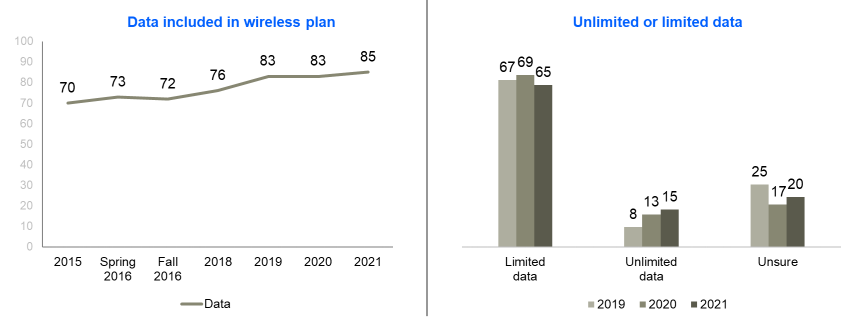
There are two graphs on this figure, the first titled “Data included in wireless plan” is a horizontal line graph showing data used in the wireless plan over time. The 1371 respondents in the 2021 survey answered as follows:
Yes, 85%
The 1306 respondents in the 2020 survey answered as follows:
Yes, 83%
The 1322 respondents in the 2019 survey answered as follows:
Yes, 83%
The 1111 respondents in the 2018 survey answered as follows:
Yes, 76%
1277 respondents in the fall 2016 survey answered as follows:
Yes, 72%
The 925 respondents in the spring 2016 survey answered as follows:
Yes, 73%
The 1005 respondents in the 2015 survey answered as follows:
Yes, 70%
The second graph titled “Unlimited or limited data” is a vertical bar graph showing the proportion of people with limited data and unlimited data in their wireless plan. The 1144 respondents who have data in their wireless plan in the 2021 survey answered as follows:
Limited data, 65%
Unlimited data, 15%
Unsure, 20%
The 1054 respondents who have data in their wireless plan in the 2020 survey answered as follows:
Limited data, 69%
Unlimited data, 13%
Unsure, 17%
The 1076 respondents who have data in their wireless plan in the 2019 survey answered as follows:
Limited data, 67%
Unlimited data, 8%
Unsure, 25%
QB2a. Which of the following are included in your wireless plan?
Base: Respondents who own a cell-phone, 2021 (n=1,371); 2020 (n=1,306); 2019 (n=1,322)
QB4. Does your plan include unlimited or limited data?
Base: Respondents who have data included in the wireless plan, 2021 (n=1,144); 2020 (n=1,054); 2019 (n=1,076)
As outlined in Tables 4.2.b and 4.2.c, a variety of demographic factors continue to influence whether or not Canadians have wireless plans that include data:
| Data included in wireless plan | Total (A) |
Age | Region | ||||||||||
|---|---|---|---|---|---|---|---|---|---|---|---|---|---|
| 18-34 (D) |
35-54 (E) |
55+ (F) |
55-64 (G) |
65-74 (H) |
75+ (I) |
Atlantic (J) |
Quebec (K) |
Ontario (L) |
Prairies (M) |
B.C. (N) |
Terri-tories (R) |
||
| Base=actual | 1371 | 209 | 465 | 679 | 299 | 241 | 119 | 130 | 266 | 384 | 387 | 154 | 50 |
| Yes | 85 | 93 FGHI | 90 FHI | 75 | 87 HI | 70 I | 57 | 79 | 84 | 86 | 89 JR | 89 J | 76 |
QB2a. Which of the following are included in your wireless plan?
Note: Letters denote statistically significant difference. For example, if there is a B then the result is significantly higher than the corresponding result in column B.
| Data included in wireless plan | Total (A) |
Income | ||||
|---|---|---|---|---|---|---|
| Under $40K (E) |
$40K to under $60K (F) | $60K to under $100K (G) |
$100K to under $150K (H) | $150K + (I) |
||
| Base=actual | 1371 | 154 | 136 | 286 | 189 | 199 |
| Yes | 98 | 77 | 76 | 86 EF | 93 EF | 95 EFG |
QB2a. Which of the following are included in your wireless plan?
Note: Letters denote statistically significant difference. For example, if there is a B then the result is significantly higher than the corresponding result in column B.
Consistent with previous years, the vast majority of Canadians who have data in their wireless plans try to manage or limit their data use (97%). The primary methods for doing this continues to be using Wi-Fi where available (94%), followed by reducing data when notified (63%), and/or using tools to monitor data usage (41%).
As outlined in Table 4.2.1.b, younger Canadians (18-54) are more likely to employ activities to manage or limit data usage than their older counterparts (55+) (99-100% vs. 82-96%). Those 75+ are least likely to employ activities to manage their data (82%). More specifically, they are less likely to switch to Wi-Fi when available (96-99% for 18-54 vs. 76-92% for 55+), reduce data usage when notified (67-72% for 18-54 vs. 45-61% among those 55-65, and 28% among those 75+), and monitor data usage with tools (45-51% for 18-54 vs. 29-37% for 55-64, and 5% for 75+).
As expected, those who have experienced bill shock in the past are more likely to reduce data usage when notified (72% vs. 60%). This is outlined in Table 4.2.1.b.

This horizontal bar graph shows the activities done to manage or limit data use.
The 966 respondents who have data included in their wireless plan in the 2021 survey answered as follows:
Use Wi-Fi when available instead of data, 94%
Reduce data use after getting a notification, 63%
Use tools to track data use, 41%
I do not limit my data use, 1%
Other, 0%
Don't use data/don't use much data, 1%
The 898 respondents who have data included in their wireless plan in the 2020 survey answered as follows:
Use Wi-Fi when available instead of data, 92%
Reduce data use after getting a notification, 68%
Use tools to track data use, 45%
I do not limit my data use, 2%
Other, 3%
Don't use data/don't use much data, 0%
The 971 respondents who have data included in their wireless plan in the 2019 survey answered as follows:
Use Wi-Fi when available instead of data, 92%
Reduce data use after getting a notification, 66%
Use tools to track data use, 47%
I do not limit my data use, 2%
Other, 1%
Don't use data/don't use much data, 1%
The 651 respondents who have data included in their wireless plan in the 2018 survey answered as follows:
Use Wi-Fi when available instead of data, 95%
Reduce data use after getting a notification, 74%
Use tools to track data use, 55%
I do not limit my data use, 2%
Other, 1%
Don't use data/don't use much data, 1%
The 831 respondents who have data included in their wireless plan in the fall 2016 survey answered as follows:
Use Wi-Fi when available instead of data, 83%
Reduce data use after getting a notification, 52%
Use tools to track data use, 36%
I do not limit my data use, 9%
Other, 1%
Don't use data/don't use much data, 1%
QB5a. [ASK If do not answer “Unlimited or None” to B4] Which of the following activities, if any, do you use to manage or limit your data use? Select all that apply.
Base: Respondents who have data included in the wireless plan, 2021 (n=966), 2020 (n=898), 2019 (n=971), 2018 (n=651), fall 2016 (n=831)
| Activities to manage to limit data use | Total (A) | Age | Bill Shock | ||||||
|---|---|---|---|---|---|---|---|---|---|
| 18-34 (D) |
35-54 (E) |
55+ (F) |
55-64 (G) |
65-74 (H) |
75+ (I) |
Yes (P) | No (Q) | ||
| Base=actual | 966 | 153 | 356 | 445 | 222 | 151 | 60 | 159 | 796 |
| ANY (NET) | 97 | 100FHI | 99FGHI | 94 | 96I | 95I | 82 | 98 | 97 |
| Use Wi-Fi | 94 | 99FGHI | 96FGHI | 88 | 92I | 88 | 76 | 94 | 94 |
| Don’t use cellular data at all | 1 | * | 1 | 1 | 2 | * | - | 1 | * |
| Turn off data when reached data limit/Automatically block data when reached limit | 2 | 2 | 2 | 1 | 1 | - | - | 1 | 2 |
| Turn off data/Turn on airplane mode/Turn off phone | 3 | 3 | 2 | 3 | 3 | 3 | - | 4 | 2 |
| Avoid activities that use large amounts of cellular data (e.g. streaming video, games, etc.) | 1 | 1 | 2 | 1 | 1 | 1 | 2 | 3 | 1 |
| Monitor data usage using phone/Application on phone | 42 | 51FGHI | 47FGHI | 30 | 37I | 29I | 5 | 45 | 42 |
| Notifications when reached/close to data limit | 1 | 4EF | * | * | * | - | - | - | 2 |
| Monitor data usage/Review bill | * | - | * | 1 | 1 | 2 | - | 1 | * |
| Use another device (e.g. computer) to access Internet | 2 | * | 3 | 3 | 2 | 3 | 2 | 2 | 2 |
| Purchase more data | - | - | - | - | - | - | - | - | - |
| Restrict social media (e.g. Facebook, etc.) | * | - | * | * | 1 | - | - | - | * |
| Reduce your data use after you get a notification that you are nearing your limit | 63 | 72FHI | 67FHI | 50 | 61HI | 45 | 28 | 72Q | 60 |
| I do not limit my data use | * | * | - | 1 | - | 2 | 2 | - | 1 |
| Other | * | * | - | * | - | 1 | - | 1 | * |
| None | 3 | * | 1 | 6DE | 4E | 5DE | 18DEGH | 2 | 3 |
QB5a. Which of the following activities, if any, do you use to manage or limit your data use? Select all that apply.
Note: Letters denote statistically significant difference. For example, if there is a B then the result is significantly higher than the corresponding result in column B.
* Denotes less than 1%
- Denotes 0
Canadians are increasingly likely to find it easy to manage their data each month. More than four-in-five Canadians (85%) consider it easy (vs. 81% in 2020; 5, 6 or 7 on a scale of 1-7)
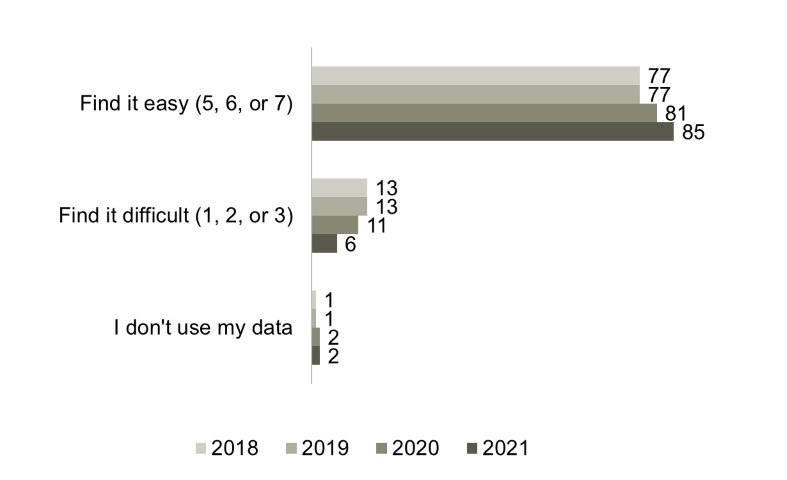
This horizontal bar graph shows the level of difficulty to manage data each month. The 1139 respondents who have data included in their wireless plan in the 2021 survey answered as follows:
Find it easy (5, 6 or 7), 85%
Find it difficult (1, 2 or 3), 6%
I don’t use my data, 2%
The 1039 respondents who have data included in their wireless plan in the 2020 survey answered as follows:
Find it easy (5, 6 or 7), 81%
Find it difficult (1, 2 or 3), 11%
I don’t use my data, 2%
The 1069 respondents who have data included in their wireless plan in the 2019 survey answered as follows:
Find it easy (5, 6 or 7), 77%
Find it difficult (1, 2 or 3), 13%
I don’t use my data, 1%
The 796 respondents who have data included in their wireless plan in the 2018 survey answered as follows:
Find it easy (5, 6 or 7), 77%
Find it difficult (1, 2 or 3), 13%
I don’t use my data, 1%
WC6. [ASK If answered “Data” to B2a and not code 3 (NO DATA) at B4]
How easy do you find it to manage the data used by yourself and/or your family each month?
Please use a 7-point scale where 1 means extremely difficult and 7 means extremely easy.
Base: Total respondents who have data included in their plan, 2021 (n=1,139), 2020 (n=1,039), 2019 (n=1,069), 2018 (n=792)
Fewer Canadians are paying data overage fees compared to previous years. One-quarter (27%) have paid data overages in the past 12 months, compared to nearly half (41-49%) from 2018-2020. However, as noted previously, this may be a function of COVID-19 restrictions, as Canadians are more likely to be at home using their home Internet connection.
However, age differences in data overage fees continue to exist (see Table 4.2.3.b). Younger and middle-aged Canadians (18-54) remain more likely than their older (55+) counterparts to have paid data overage fees at least once in the past year (30% vs. 19-21% among those 55+). Given that younger Canadians are also more likely to manage their data, this could be a surprising finding or it could be the reason why they are taking a more active role in managing their data use.
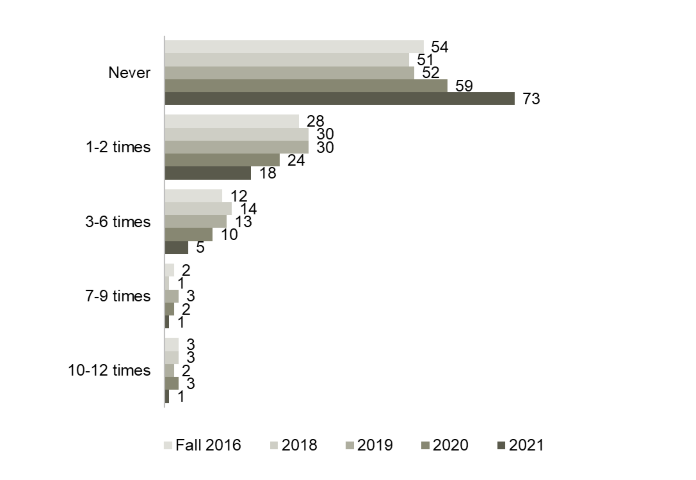
This horizontal bar graph shows how often people paid data overage fees in the past 12 months. The 1139 respondents who have data include in their wireless plan in the 2021 survey answered as follows:
Never, 73%
1-2 times, 18%
3-6 times, 5%
7-9 times, 1%
10-12 times, 1%
The 1039 respondents who have data include in their wireless plan in the 2020 survey answered as follows:
Never, 59%
1-2 times, 24%
3-6 times, 10%
7-9 times, 2%
10-12 times, 3%
The 1069 respondents who have data include in their wireless plan in the 2019 survey answered as follows:
Never, 52%
1-2 times, 30%
3-6 times, 13%
7-9 times, 3%
10-12 times, 2%
The 796 respondents who have data include in their wireless plan in the 2018 survey answered as follows:
Never, 51%
1-2 times, 30%
3-6 times, 14%
7-9 times, 1%
10-12 times, 3%
The 831 respondents who have data include in their wireless plan in the fall 2016 survey answered as follows:
Never, 54%
1-2 times, 28%
3-6 times, 12%
7-9 times, 2%
10-12 times, 3%
QB8. In the past 12 months, how often have you paid data overage fees?
Base: Respondents who have data included in their plan, 2021 (n-1,139); 2020 (n=1,039), 2019 (n=1,069), 2018 (n=796), fall 2016 (n=831)
| Data overage fees paid in the past 12 months | Total (A) |
Age | |||||
|---|---|---|---|---|---|---|---|
| 18-34 (D) |
35-54 (E) |
55+ (F) |
55-64 (G) |
65-74 (H) |
75+ (I) |
||
| Base=actual | 1139 | 191 | 417 | 516 | 258 | 173 | 69 |
| Never | 73 | 70 | 70 | 80DE | 79E | 81DE | 80 |
| 1-2 times | 18 | 21F | 21FG | 13 | 14 | 14 | 10 |
| 3-6 times | 5 | 8 | 5 | 4 | 5 | 2 | 4 |
| 7-9 times | 1 | 1 | 1 | * | * | - | - |
| 10-12 times | 1 | 1 | 1 | 1 | 1 | 1 | - |
| Don’t know | 2 | * | 2 | 2 | 1 | 2 | 5D |
QB8. In the past 12 months, how often have you paid data overage fees?
Note: Letters denote statistically significant difference. For example, if there is a B then the result is significantly higher than the corresponding result in column B.
* Denotes less than 1%
-Denotes 0
Incidence
Fewer Canadians are experiencing bill shock than in previous years (16% vs. 22% in 2020 and 25% in 2019), signalling a positive trend after changes were made to the Wireless Code in 2017. However, as noted these results will need to be re-examined in 2022 to determine if COVID-19 restrictions are a factor, as Canadians are more likely to be using their home Internet access and travelling less often.
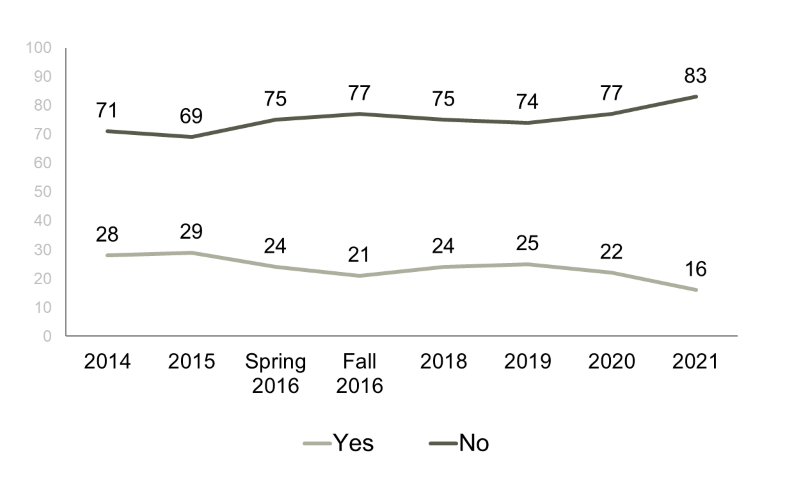
This line graph shows the proportion of people who experienced bill shock over time. The 1371 respondents in the 2021 survey answered as follows:
Yes, 16%
No, 83%
The 1306 respondents in the 2020 survey answered as follows:
Yes, 22%
No, 77%
The 1322 respondents in the 2019 survey answered as follows:
Yes, 25%
No, 74%
The 1111 respondents in the 2018 survey answered as follows:
Yes, 24%
No, 75%
The 1277 respondents in the fall 2016 survey answered as follows:
Yes, 21%
No, 77%
The 925 respondents in the spring 2016 survey answered as follows:
Yes, 24%
No, 75%
The 1005 respondents in the 2015 survey answered as follows:
Yes, 29%
No, 69%
The 1016 respondents in the 2014 survey answered as follows:
Yes, 28%
No, 71%
QB10/B6. During the last year, have you experienced ‘bill shock’, meaning a surprisingly high bill?
Base: Respondents who own a cell-phone, 2021 (n=1,371); 2020 (n=1,306); 2019 (n=1,322), 2018 (n=1,111), fall 2016 (n=1,277), total respondents winter 2016 (n=925), 2015 (n=1,005), 2014 (n=1,016)
As in previous years, younger and middle-aged Canadians (18-54) continue to be more likely to experience bill shock than their older counterparts (18-20% vs. 10-13% among those 55+). Those with a university or college education are also less likely to experience bill shock than those with a high school education or less (14% vs. 22% respectively). This is outlined in Table 4.3.1.b.
Not unexpectedly, those who find it difficult to manage their data each month are more likely to experience bill shock than those who find it easy (38% vs. 14% respectively). This is outlined in Table 4.3.1.c.
| Experienced Bill Shock | Total (A) |
Age | Education | |||||||
|---|---|---|---|---|---|---|---|---|---|---|
| 18-34 (D) |
35-54 (E) |
55+ (F) |
55-64 (G) |
65-74 (H) |
75+ (I) |
HS or less (S) |
College (T) |
Univ. or more (U) |
||
| Base = actual | 1371 | 209 | 465 | 679 | 299 | 241 | 119 | 298 | 378 | 660 |
| Yes | 16 | 20FH | 18FH | 12 | 13 | 11 | 10 | 22TU | 14 | 14 |
| No | 83 | 78 | 81 | 87DE | 85 | 88DE | 89 | 76 | 85S | 84S |
| Don’t Know | 1 | 2 | 1 | 1 | 2 | 1 | 1 | 2 | 1 | 1 |
QB10. During the last year, have you experienced ‘bill shock’, meaning a surprisingly high bill?
Note: Letters denote statistically significant difference. For example, if there is a B then the result is significantly higher than the corresponding result in column B.
- Denotes 0
| Experienced Bill Shock | Total (A) | Manage Data | ||
|---|---|---|---|---|
| Easy (F) | Difficult (G) | |||
| Base = actual | 1371 | 958 | 77 | |
| Yes | 16 | 14 | 38F | |
| No | 83 | 85G | 62 | |
| Don’t Know | 1 | 1 | - | |
QB10. During the last year, have you experienced ‘bill shock’, meaning a surprisingly high bill?
Note: Letters denote statistically significant difference. For example, if there is a B then the result is significantly higher than the corresponding result in column B.
- Denotes 0
Amount
The Wireless Code mandates that providers must suspend data overage charges once they exceed $50 unless an authorized user consents to paying additional fees. Despite this, Canadians continue to experience a range of unexpected charges, varying from less than $50 to over $1,000 per billing cycle. As in previous years, most of the unexpected charges continue to be less than $50 (30%) or between $50 and $100 (37%).
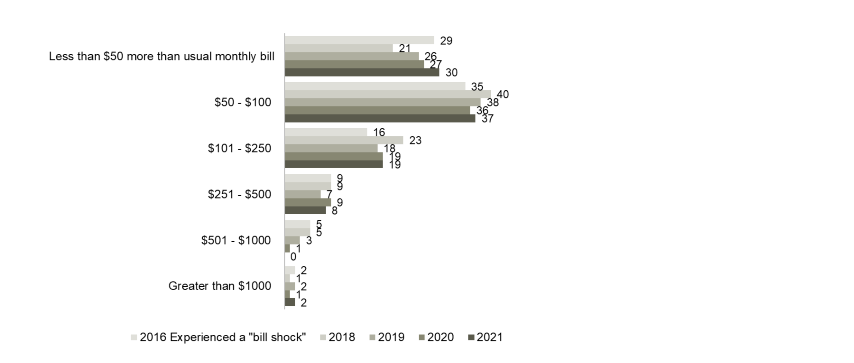
This horizontal bar graph shows the amount of unexpected charges on a bill among those who have experienced “bill shock”. The 201 respondents who have experienced bill shock in the 2021 survey answered as follows:
Less than $50 more than usual monthly bill, 30%
$50-$100, 37%
$101-$250, 19%
$251-$500, 8%
$501-$1000, 0%
Greater than $1000, 2%
The 261 respondents who have experienced bill shock in the 2020 survey answered as follows:
Less than $50 more than usual monthly bill, 27%
$50-$100, 36%
$101-$250, 19%
$251-$500, 9%
$501-$1000, 1%
Greater than $1000, 1%
The 320 respondents who have experienced bill shock in the 2019 survey answered as follows:
Less than $50 more than usual monthly bill, 26%
$50-$100, 38%
$101-$250, 18%
$251-$500, 7%
$501-$1000, 3%
Greater than $1000, 2%
The 211 respondents who have experienced bill shock in the 2018 survey answered as follows:
Less than $50 more than usual monthly bill, 21%
$50-$100, 40%
$101-$250, 23%
$251-$500, 9%
$501-$1000, 5%
Greater than $1000, 1%
The 250 respondents who have experienced bill shock in the 2016 survey answered as follows:
Less than $50 more than usual monthly bill, 29%
$50-$100, 35%
$101-$250, 16%
$251-$500, 9%
$501-$1000, 5%
Greater than $1000, 2%
Q10b. What was the amount of the unexpected charges on your bill?
Base: Respondents who have experienced a “bill shock”, 2021 (n=201); 2020 (n=261); 2019 (n=320), 2018 (n=211); Fall 2016 (n=285)
Reason
Data overage fees continue to be the primary stated reason for bill shock (41%), though this has decreased since 2020 (50%). Long distance fees have increased as a stated reason (16% vs. 7% in 2020) while international roaming fees have decreased (7% vs. 17%). However, it is possible this trend reflects the impact of COVID-19 restrictions, are Canadians are less likely to travel and may be more likely to spend time connecting with others via phone. Complete details can be found in Exhibit 4.3.1.e below.

This horizontal bar graph shows the main reasons why people experience bill shock. The 201 respondents who experienced bill shock in the 2021 survey answered as follows:
Data overage fees, 41%
International travel, 7%
Long distance fees, 16%
Billing issues/errors/mistakes, 4%
Unexpected set-up fee or service charge, 4%
Unexpected fees, 8%
Domestic travel, 7%
Difficulties managing use of family/shared plans, 2%
Not given the plan/deal promised, 4%
Call minute overage fees, 2%
Text overage fees, less than 3%
Other, 11%
The 261 respondents who experienced bill shock in the 2020 survey answered as follows:
Data overage fees, 50%
International travel, 17%
Long distance fees, 7%
Billing issues/errors/mistakes, 7%
Unexpected set-up fee or service charge, 7%
Unexpected fees, 4%
Domestic travel, 4%
Difficulties managing use of family/shared plans, 4%
Not given the plan/deal promised, 3%
Call minute overage fees, 3%
Text overage fees, less than 1%
Other, 4%
The 320 respondents who experienced bill shock in the 2019 survey answered as follows:
Data overage fees, 56%
International travel, 12%
Long distance fees, 9%
Billing issues/errors/mistakes, 6%
Not given the plan/deal promised, 4%
Unexpected fees, 4%
Domestic travel, 4%
Call minute overage fees, 2%
Difficulties managing use of family/shared plans, 2%
Unexpected set-up fee or service charge, 2%
Text overage fees, less than 1%
Other, 3%
The 211 respondents who experienced bill shock in the 2018 survey answered as follows:
Data overage fees, 43%
International travel, 19%
Long distance fees, 14%
Call minute overage fees, 5%
Billing issues/errors/mistakes, 5%
Difficulties managing use of family/shared plans, 5%
Domestic travel, 4%
Not given the plan/deal promised, 4%
Other, 3%
Unexpected fees, 4%
Unexpected set-up fee or service charge, 1%
Text overage fees, less than 1%
The 250 respondents who experienced bill shock in the 2016 survey answered as follows:
Data overage fees, 48%
International travel, 17%
Long distance fees, 9%
Call minute overage fees, 14%
Billing issues/errors/mistakes, 8%
Difficulties managing use of family/shared plans, 4%
Domestic travel, 8%
Not given the plan/deal promised, 1%
Other, 2%
Unexpected fees, 6%
Unexpected set-up fee or service charge, 3%
Text overage fees, 4%
QB10a/B6a. What was the main reason for the ‘bill shock’ you experienced?
Base: Those who experienced ‘bill shock’, 2021 (n=201); 2020 (n=261); 2019 (n=320), 2018 (n=211), fall 2016 (n=250), winter 2016 (n=208), 2015 (n=289), 2014 (n=282)
The Wireless Code requires service providers to notify customers when they are roaming and to cap data roaming fees at $100 per billing cycle unless the customer expressly consents to pay additional charges.
Most Canadians feel they are able to manage their roaming charges while travelling and little has changed since 2016. More than half of Canadians (51%) continue to find it easy to manage roaming fees (5, 6 or 7 on a scale of 1-7) while 15 per cent Canadians find it difficult (1, 2 or 3 on a scale of 1-7).
As outlined in Table 4.3.2.b, those whose first language is not an official language are more likely to report difficultly managing roaming charges than those whose first language is French or English (24% vs. 11-15%; 1, 2 or 3 on a scale of 1-7).

This horizontal bar graph shows the proportion of people who find it easy or who find it difficult to manage roaming charges when travelling. The 1371 respondents in the 2021 survey answered as follows:
Find it easy (5, 6 or 7), 51%
Find it difficult (1, 2 or 3), 15%
The 1306 respondents in the 2020 survey answered as follows:
Find it easy (5, 6 or 7), 51%
Find it difficult (1, 2 or 3), 19%
The 1322 respondents in the 2019 survey answered as follows:
Find it easy (5, 6 or 7), 53%
Find it difficult (1, 2 or 3), 16%
The 1111 respondents in the 2018 survey answered as follows:
Find it easy (5, 6 or 7), 52%
Find it difficult (1, 2 or 3), 17%
The 1277 respondents in the fall 2016 survey answered as follows:
Find it easy (5, 6 or 7), 53%
Find it difficult (1, 2 or 3), 17%
QB9. If you use your plan while travelling, you may be charged roaming fees. How easy do you find it to manage your roaming charges when you are travelling? Please use a 7-point scale where 1 means extremely difficult and 7 means extremely easy.
Base: Respondents who own a cell-phone, 2021 (n=1,371); 2020 (n=1,306); 2019 (n=1,322), 2018 (n=1,111); fall 2016 (n=1,277)
Unsurprisingly, those who have made a complaint (31%) are more likely to find it difficult to manage roaming charges than those who have not (12%), as are those who have experienced bill shock compared to those who have not (33% vs. 11%).
| Level of difficulty managing roaming charges when travelling | Language | ||
|---|---|---|---|
| Eng (B) |
Fr (C) |
Other (D) |
|
| Base = actual | 960 | 254 | 157 |
| Find it easy (5,6,7) | 53D | 52D | 37 |
| Find it difficult (1, 2, 3) | 15 | 11 | 24BC |
QB9. If you use your plan while travelling, you may be charged roaming fees. How easy do you find it to manage your roaming charges when you are travelling?
Note: Letters denote statistically significant difference. For example, if there is a B then the result is significantly higher than the corresponding result in column B.
The Wireless Code includes several rules related to contract clarity, including requiring service providers to give customers a critical information summary that highlights the most important terms of their contract.
Canadians’ understanding of their contracts has increased over the past year (+5%), with the majority (62%) continuing to find their wireless contract clear and easy to understand (5, 6 or 7 on a scale of 1-7). As outlined in Table 4.4.1.b., those who have experienced bill shock in the past year are much more likely to state they find their contract difficult to understand (32% vs. 15%; 1,2 or 3 on a scale of 1-7).

This horizontal bar graph shows the level of ease of understanding wireless their wireless contract.
The 1371 respondents in the 2021 survey answered as follows:
Find it clear and easy to understand (5, 6 or 7), 62%
Find it unclear and difficult to understand (1, 2 or 3), 18%
Do not have a contract, 4%
Never read the agreement, 2%
The 1306 respondents in the 2020 survey answered as follows:
Find it clear and easy to understand (5, 6 or 7), 57%
Find it unclear and difficult to understand (1, 2 or 3), 23%
Do not have a contract, 4%
Never read the agreement, 4%
The 1322 respondents in the 2019 survey answered as follows:
Find it clear and easy to understand (5, 6 or 7), 58%
Find it unclear and difficult to understand (1, 2 or 3), 20%
Do not have a contract, 4%
Never read the agreement, 3%
The 1111 respondents in the 2018 survey answered as follows:
Find it clear and easy to understand (5, 6 or 7), 61%
Find it unclear and difficult to understand (1, 2 or 3), 17%
Do not have a contract, 5%
Never read the agreement, 5%
WC10. Do you find your contract clear and easy to understand? Please use a 7-point scale where 1 means extremely unclear and difficult to understand and 7 means extremely clear and easy to understand.
Base: Total respondents who own a cell-phone, 2021 (n=1,371); 2020 (n=1,306); 2019 (n=1,322), 2018 (n=1,111)
| Level of ease of understanding wireless contract | Total (A) | Bill Shock | |
|---|---|---|---|
| Yes (P) | No (Q) | ||
| Base=actual | 1371 | 201 | 1153 |
| Find it easy (5, 6 or 7) | 62 | 46 | 65P |
| Find it difficult (1, 2 or 3) | 18 | 32Q | 15 |
WC10. Do you find your contract clear and easy to understand? Please use a 7-point scale where 1 means extremely unclear and difficult to understand and 7 means extremely clear and easy to understand.
Note: Letters denote statistically significant difference. For example, if there is a B then the result is significantly higher than the corresponding result in column B.
Since 2013, the Wireless Code has required service providers to include a trial period for new contracts. During the trial period, wireless contract holders can cancel their contract without penalty. The trial period must be a minimum of 15 days' service and as of December 1, 2017, it must permit the customer to use up to half the voice, text, and data usage amounts included in their monthly plan.
Little has changed over the past year regarding how clear Canadians found the explanation of the trial period when they took out their wireless contract. Slightly more found it unclear (36%; 1, 2 or 3 on a scale of 1-7) than clear (34%; 5, 6 or 7 on a scale of 1-7). A minority continues to state they have not read their contract (2%) or they do not have a contract (4%) or trial period (6%).
As outlined in Table 4.4.2.b, younger Canadians (18-54) are more likely to find the explanation of the trial period unclear (41-39% vs. 23-30% among those 55+). As with other aspects related to the ease of managing and understanding plans, Canadians who experienced bill shock are more likely to have found the explanation of the trial period unclear (53% vs. 33%), as are those who have filed a complaint in the past 12 months (54% vs. 32%). This may signal that general confusion continues to exist among some Canadians related to both setting up and later managing their contracts.

This horizontal bar graph shows the proportion of people who find it clear or who find it unclear to understand the explanation of the trail period. The 1371 respondents in the 2021 survey answered as follows:
Find it clear (5, 6 or 7), 34%
Find it unclear (1, 2 or 3), 36%
Do not have a contract, 4%
Never read the agreement, 2%
Did not have a trial period, 6%
The 1306 respondents in the 2020 survey answered as follows:
Find it clear (5, 6 or 7), 35%
Find it unclear (1, 2 or 3), 41%
Do not have a contract, 4%
Never read the agreement, 1%
Did not have a trial period, 4%
The 1322 respondents in the 2019 survey answered as follows:
Find it clear (5, 6 or 7), 32%
Find it unclear (1, 2 or 3), 40%
Do not have a contract, 4%
Never read the agreement, 2%
Did not have a trial period, 5%
The 1111 respondents in the 2018 survey answered as follows:
Find it clear (5, 6 or 7), 36%
Find it unclear (1, 2 or 3), 34%
Do not have a contract, 4%
Never read the agreement, 2%
Did not have a trial period, 4%
WC8. The Code requires service providers to include a trial period for new contracts that include a device. During the trial period, you can cancel your contract without penalty. This trial period now has to be half of a month of service and include half the service included in your monthly plan.
How clearly did your service provider explain the trial period to you?
Please use a 7-point scale where 1 means extremely unclear and 7 means extremely clear.
Base: Total respondents who own a cell-phone, 2021 (n=1,371); 2020 (n=1,306); 2019 (n=1,322), 2018 (n=1,111)
*Denotes less than 1%
| Explanation of trial period | Total (A) |
Age | Complaints | Bill Shock | |||||||
|---|---|---|---|---|---|---|---|---|---|---|---|
| 18-34 (D) |
35-54 (E) |
55+ (F) |
55-64 (G) |
65-74 (H) |
75+ (I) |
Made one (V) |
Did not make one (W) |
Yes (P) |
No (Q) |
||
| Base=actual | 1371 | 209 | 465 | 679 | 299 | 241 | 119 | 203 | 1160 | 201 | 1153 |
| Find it clear (5, 6 or 7) | 34 | 33 | 32 | 36 | 37 | 38 | 31 | 22 | 36 V | 24 | 36 P |
| Find it unclear (1, 2 or 3) | 36 | 41FGHI | 39FGHI | 28 | 30 | 28 | 23 | 54 W | 32 | 53 Q | 33 |
| Do not have a contract | 4 | 2 | 3 | 5 | 4 | 2 | 12DEGH | 3 | 4 | 3 | 4 |
| Never read the agreement | 2 | 3 | 2 | 2 | 1 | 3 | 2 | 2 | 2 | 3 | 2 |
| Did not have a trial period | 6 | 4 | 4 | 9E | 8 | 8 | 11DE | 5 | 7 | 5 | 7 |
| Don't Know | 12 | 9 | 12 | 15 | 13 | 14 | 18D | 7 | 13V | 5 | 13P |
WC8. The Code requires service providers to include a trial period for new contracts that include a device. During the trial period, you can cancel your contract without penalty. This trial period now has to be half of a month of service and include half the service included in your monthly plan.
Note: Letters denote statistically significant difference. For example, if there is a B then the result is significantly higher than the corresponding result in column B.
* Denotes less than 1%
-Denotes 0
The Wireless Code includes several rules on cancellation fees, establishing formulas for calculating the maximum cancellation fee that a service provider may charge, requiring disclosure of any fees in the contract and critical information summary, and limiting cancellation fees to two years.
Most service providers require customers to pay a cancellation fee if they cancel their contracts before the agreed upon end date. This needs to be carefully explained to the consumer for them to be fully aware of the implications of early cancellation. Consistent with 2020, half (51%) of Canadians who have wireless plans find the explanation to be clear, while close to one quarter find it unclear (26%; rated 1, 2 or 3 on a scale from 1-7). Given that this has not changed over the past four years, this signals a need for service providers to provide greater clarity around cancellation fees, or that current contracts may continue be difficult for many consumers to understand.

This horizontal bar graph shows the proportion of people who find it clear or who find it unclear to understand the explanation of the fee for early cancellation of a contract. The 1371 respondents in the 2021 survey answered as follows:
Find it clear (5, 6 or 7), 51%
Find it unclear (1, 2 or 3), 26%
Do not have a contract, 5%
Never read the agreement, 2%
The 1306 respondents in the 2020 survey answered as follows:
Find it clear (5, 6 or 7), 49%
Find it unclear (1, 2 or 3), 30%
Do not have a contract, 5%
Never read the agreement, 1%
The 1322 respondents in the 2019 survey answered as follows:
Find it clear (5, 6 or 7), 50%
Find it unclear (1, 2 or 3), 30%
Do not have a contract, 5%
Never read the agreement, 1%
The 1111 respondents in the 2018 survey answered as follows:
Find it clear (5, 6 or 7), 50%
Find it unclear (1, 2 or 3), 26%
Do not have a contract, 5%
Never read the agreement, 2%
WC9. When you signed your contract or accepted your service agreement, how clearly did your service provider explain any fees that would apply if you cancel your contract or agreement early? Please use a 7-point scale where 1 means extremely unclear and 7 means extremely clear.
Base: Total respondents who own a cell-phone, 2021 (n=1,371); 2020 (n=1,306); 2019 (n=1,322), 2018 (n=1,111)
The Wireless Code prevents service providers from making changes to the key terms of postpaid contracts without the customer’s express consent and requires providers to notify customers prior to making changes to non-key terms.
A small but significant portion of Canadians state that changes to wireless services were made without expressly making them aware of the new terms and conditions (15%), which has remained steady over the previous three years (12-16%).
In-line with previous years, changes to wireless services without expressly making the consumer aware of the new terms and conditions is reported more often by those who have made a complaint in the last 12 months (26% vs. 12%), as well as by those who report bill shock (27% vs. 12%). This suggests that a common factor may underlie these issues, such as unexpected service changes or an unclear contract. This is outlined in Table 4.5.1.b.
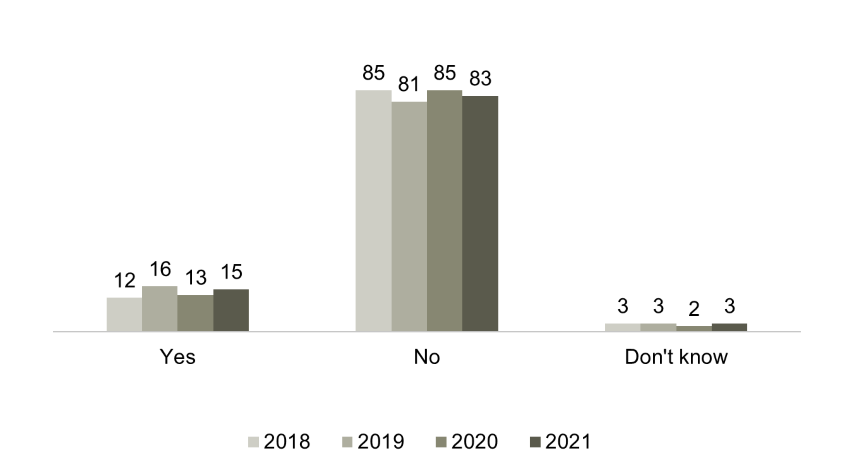
This pie graph shows if respondents became aware that their service provider changed their plan terms and conditions without disclosure. The 1371 respondents in the 2021 survey answered as follows:
Yes, 15%
No, 83%
Don’t know, 3%
The 1306 respondents in the 2020 survey answered as follows:
Yes, 13%
No, 85%
Don’t know, 2%
The 1322 respondents in the 2019 survey answered as follows:
Yes, 16%
No, 81%
Don’t know, 3%
The 1111 respondents in the 2018 survey answered as follows:
Yes, 12%
No, 85%
Don’t know, 3%
WC11. Have you ever become aware that your service provider changed your plan without expressly making you aware of how the terms and conditions had changed?
Base: Total respondents who own a cell-phone, 2021 (n=1,371); 2020 (n=1,306); 2019 (n=1,322), 2018 (n=1,111)
| Changes to contract without disclosure of changes in terms and conditions | Total (A) |
Complaints | Bill Shock | ||
|---|---|---|---|---|---|
| Made one (V) |
Did not make one (W) |
Yes (P) |
No (Q) |
||
| Base=actual | 1371 | 203 | 1160 | 201 | 1153 |
| Yes | 15 | 26W | 12 | 27Q | 12 |
| No | 83 | 70 | 85V | 68 | 86P |
| Don’t know | 3 | 3 | 3 | 5 | 2 |
WC11. Have you ever become aware that your service provider changed your plan without expressly making you aware of how the terms and conditions had changed?
Note: Letters denote statistically significant difference. For example, if there is a B then the result is significantly higher than the corresponding result in column B.
When the Wireless Code was created in 2013, it prevented service providers from charging early cancellation fees after a period of 2 years, in the interest of making it easier for consumers to switch providers to take advantage of competitive offers.
The number of Canadians who have changed their service provider remains steady at 20 per cent. As in previous years, the most common reasons stated for changing providers include being offered a better deal (53%), no longer being satisfied with a service provider (24%) and/or needing an upgrade (7%). Full details are outlined in Exhibit 4.5.2.a.

There are two graphs on this figure, the first titled “Have you changed wireless service providers in the last two years?” is a vertical bar graph showing the proportion of people who have changed their service provider and those who have not. The 1371 respondents in the 2020 survey answered as follows:
Yes, 20%
No, 79%
Don’t know, 0%
The 1306 respondents in the 2020 survey answered as follows:
Yes, 20%
No, 79%
Don’t know, 1%
The 1322 respondents in the 2019 survey answered as follows:
Yes, 18%
No, 81%
Don’t know, 1%
The 1111 respondents in the 2018 survey answered as follows:
Yes, 16%
No, 84%
Don’t know, less than 1%
The second graph, titled “Reasons for changing wireless service providers” is also a vertical bar graph showing the extent to which each reason was applicable to the respondents. The 254 respondents in the 2021 survey who did change service providers in the last two years answered as follows:
Offered a better deal with a different provider, 53%
You were no longer satisfied with your service provider, 24%
Needed a new phone or to upgrade phone, 7%
Your contract had ended, 5%
Don’t know, 0%
The 233 respondents in the 2020 survey who did change service providers in the last two years answered as follows:
Offered a better deal with a different provider, 58%
You were no longer satisfied with your service provider, 37%
Needed a new phone or to upgrade phone, 9%
Your contract had ended, 6%
Don’t know, 3%
The 231 respondents in the 2019 survey who did change service providers in the last two years answered as follows:
Offered a better deal with a different provider, 45%
You were no longer satisfied with your service provider, 14%
Needed a new phone or to upgrade phone, 9%
Your contract had ended, 4%
Don’t know, 1%
The 152 respondents in the 2018 survey who did change service providers in the last two years answered as follows:
Offered a better deal with a different provider, 49%
You were no longer satisfied with your service provider, 19%
Needed a new phone or to upgrade phone, 13%
Your contract had ended, 3%
Don’t know, less than 1%
WC16. Have you changed wireless service providers in the last two years?
Base: Total respondents who own a cell-phone, 2021 (n=1,371); 2020 (n=1,306); 2019 (n=1,322), 2018 (n=1,111)
WC12. [If answered “Yes” to WC16] Why did you change service provider?
Base: Total respondents who changed their service provider in P2Y, 2021 (n=254); 2020 (n=233), 2019 (n=231), 2018 (n=152)
The vast majority (88%) say they were easily able to navigate the change process (5, 6 or 7 on a scale of 1-7). This reflects a significant increase over the previous three years (79-83% in 2018 – 2020).
Among the seven per cent of Canadians who found the process difficult (rated 1, 2 or 3 on a scale from 1-7); the high cost of ending their contract (29%), technical issues (19%), or difficulty retaining a phone number (10%) continued to be the main reasons for difficulties.
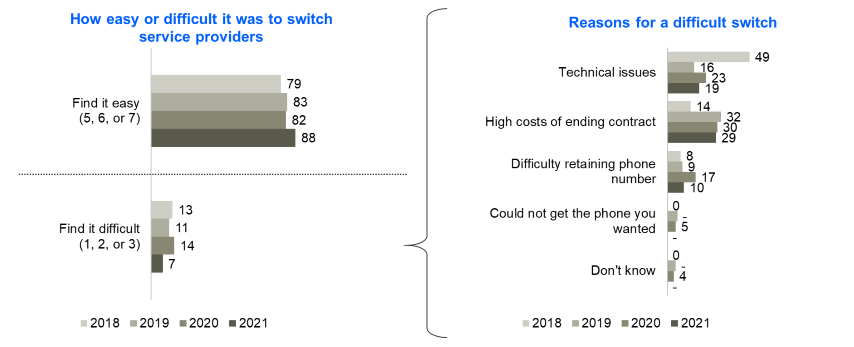
There are two graphs on this figure, the first titled “How easy or difficult it was to switch service providers” is a vertical bar graph showing the proportion of people who found it easy and those who found it difficult. The 254 respondents in the 2021 survey who changed service providers in the last two years answered as follows:
Find it easy (5, 6 or 7), 88%
Find it difficult, (1, 2 or 3), 7%
The 233 respondents in the 2020 survey who changed service providers in the last two years answered as follows:
Find it easy (5, 6 or 7), 82%
Find it difficult, (1, 2 or 3), 14%
The 231 respondents in the 2019 survey who changed service providers in the last two years answered as follows:
Find it easy (5, 6 or 7), 83%
Find it difficult, (1, 2 or 3), 11%
The 152 respondents in the 2018 survey who changed service providers in the last two years answered as follows:
Find it easy (5, 6 or 7), 79%
Find id difficult, (1, 2 or 3), 13%
The second graph, titled “Reasons for a difficult switch” is also a vertical bar graph showing the extent to which each reason was applicable to the respondents. The 23 respondents in the 2021 survey who found it difficult to switch answered as follows:
Technical issues, 19%
High cost of ending contract, 29%
Difficulty retaining phone number, 10%
Could not get the phone you wanted, 0%
Don’t know, 0%
The 29 respondents in the 2020 survey who found it difficult to switch answered as follows:
Technical issues, 23%
High cost of ending contract, 30%
Difficulty retaining phone number, 17%
Could not get the phone you wanted, 5%
Don’t know, 4%
The 24 respondents in the 2019 survey who found it difficult to switch answered as follows:
Technical issues, 16%
High cost of ending contract, 32%
Difficulty retaining phone number, 9%
Could not get the phone you wanted, 6%
Don’t know, 5%
The 19 respondents in the 2018 survey who found it difficult to switch answered as follows:
Technical issues, 49%
High cost of ending contract, 14%
Difficulty retaining phone number, 8%
Could not get the phone you wanted, less than 1%
Don’t know, less than 1%
WC13. [If answered “Yes” to WC16] How easy or difficult was it to switch service providers? Please use a 7-point scale where 1 means extremely difficult and 7 means extremely easy.
Base: Total respondents who changed their service provider in P2Y, 2021 (n=254); 2020 (n=233), 2019 (n=231), 2018 (n=152)
WC14. [If answered 1,2 OR 3 at WC13] Was there a reason why switching providers was difficult for you?
Base: Total respondents who find it difficult to switch, 2021 (n=23)**; 2020 (n=29)**; 2019 (n=24)**, 2018 (n=19)**
** Very Low Base < 30
Incidence
The incidence of Canadians who report having made complaints about their wireless services has remained stable, in-line with 2016 to 2020 results (16% vs. 17-21%) and continues to remain significantly lower than in 2014 (26%).
Not unexpectedly, those who find managing data difficult are still more likely to have made a complaint over the past year (32% vs. 14%); see Table 4.6.1.b. Those who are enrolled in family plans are also more likely to have made a complaint than those with individual plans (20% vs. 14% respectively).

This line graph shows the proportion of people who have made a wireless service complaint in the past 12 months over time. The 1306 respondents in the 2021 survey answered as follows:
Yes, 16%
No, 84%
The 1306 respondents in the 2020 survey answered as follows:
Yes, 17%
No, 82%
The 1322 respondents in the 2019 survey answered as follows:
Yes, 20%
No, 80%
The 1111 respondents in the 2018 survey answered as follows:
Yes, 18%
No, 82%
The 1277 respondents in the fall 2016 survey answered as follows:
Yes, 17%
No, 83%
The 925 respondents in the spring 2016 survey answered as follows:
Yes, 21%
No, 78%
The 1005 respondents in the 2015 survey answered as follows:
Yes, 23%
No, 77%
The 1016 respondents in the 2014 survey answered as follows:
Yes, 26%
No, 74%
QB11a/QB11/QB4 Have you made a complaint about your wireless services in the past 12 months?
Base: Respondents who own a cell-phone, 2021 (n=1,371); 2020 (n=1,306); 2019 (1,322), 2018 (n=1,111), Fall 2016 (n=1,277), Winter 2016 (n=925), 2015 (n=1,005), 2014 (n=1,016)
| Wireless Service Complaint Made | Total (A) |
Plan | Manage Data | ||
|---|---|---|---|---|---|
| Family (J) |
Individual (K) |
Easy (F) |
Difficult (G) |
||
| Base=actual | 1371 | 426 | 925 | 958 | 77 |
| Yes | 16 | 20K | 14 | 14 | 32F |
| No | 84 | 79 | 85J | 85G | 68 |
| Don’t know | 1 | 1 | * | 1 | - |
QB11a. Have you made a complaint about your wireless services in the past 12 months?
Note: Letters denote statistically significant difference. For example, if there is a B then the result is significantly higher than the corresponding result in column B.
* Denotes less than 1%
- Denotes 0
Reasons for complaints
There have been a number of shifts in the reasons behind complaints over the past year. Inadequate quality of service is now the top stated reason (29% in 2021 vs. 22% in 2020). Complaints regarding incorrect charges have decreased (20% in 2021 vs. 35% in 2020). However, as mentioned previously, COVID-19 restrictions are likely a factor in data overage charges, as Canadians have greater access to their home Internet access or alternative devices at home. Complete details can be found in Exhibit 4.6.1.c below.
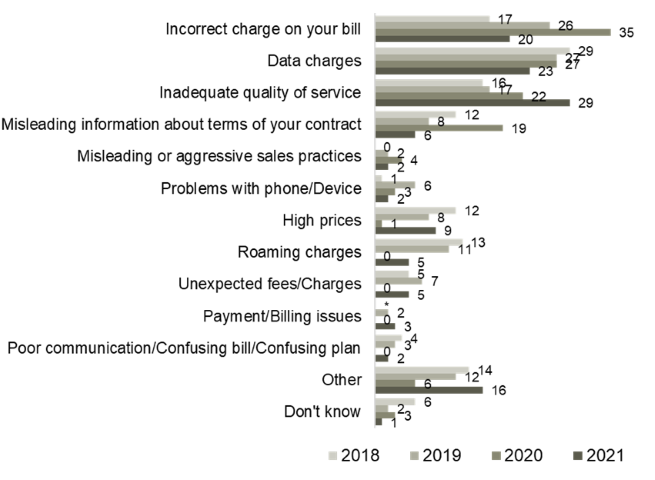
This horizontal bar graph shows the reasons for respondents complaining in the past 12 months. This horizontal bar graph shows the reasons for respondents complaining in the past 12 months. The 203 respondents in the 2021 survey answered as follows:
Incorrect charges on bill, 20%
Data charges, 23%
Inadequate quality of service, 29%
Misleading contract information, 6%
Misleading or aggressive sales practices, 2%
Problems with phone, 2%
High prices, 9%
Roaming charges, 5%
Unexpected fees, 5%
Poor communication/confusing plan, 2%
Payment/billing issues, 2%
Other, 16%
Don’t know, 1%
The 222 respondents in the 2020 survey answered as follows:
Incorrect charges on bill, 35%
Data charges, 27%
Inadequate quality of service, 22%
Misleading contract information, 19%
Misleading or aggressive sales practices, 4%
Problems with phone, 3%
High prices, 1%
Roaming charges, 0%
Unexpected fees, 0%
Poor communication/confusing plan, 0%
Payment/billing issues, 0%
Other, 6%
Don’t know, 3%
The 255 respondents in the 2019 survey answered as follows:
Data charges, 27%
Incorrect charges on bill, 26%
Inadequate quality of service, 17%
Roaming charges, 11%
Misleading contract information, 8%
High prices, 8%
Unexpected fees, 7%
Problems with phone, 6%
Poor communication/confusing plan, 3%
Misleading or aggressive sales practices, 2%
Payment/billing issues, 2%
Other, 12%
Don’t know, 2%
The 183 respondents in the 2018 survey answered as follows:
Data charges, 29%
Incorrect charges on bill, 17%
Inadequate quality of service, 16%
Roaming charges, 13%
Misleading contract information, 12%
High prices, 12%
Unexpected fees, 5%
Problems with phone, 1%
Poor communication/confusing plan, 4%
Misleading or aggressive sales practices, N/A
Payment/billing issues, N/A
Other, 14%
Don’t know, 6%
B11b. [ASK If answered “Yes” to B11a] What was your complaint about?
Base: Total respondents who made a complaint about the wireless services in the P12M, 2021 (n=203); 2020 (n=222); 2019 (n=255), 2018 (n=183)
Complaint Issued to Service Provider
The CCTS is mandated to review complaints from customers who are unsatisfied with how their complaint was addressed by their service provider.
Consistent with previous years, more than nine-in-ten Canadians who have made a complaint made it solely to their service provider (93%), while 4% made the complaint to both their provider and the CCTS. Almost no Canadians reported solely escalating complaints to the CCTS ( <1%), signalling that they understand the process involves contacting their provider first.

This horizontal bar graph shows the breakdown of who those people that have made a wireless complaint complained to. The 203 respondents who made a complaint in the 2021 survey answered as follows:
Your wireless service provider, 93%
CCTS, 0%
Both, 4%
The 222 respondents who made a complaint in the 2020 survey answered as follows:
Your wireless service provider, 93%
CCTS, 3%
Both, 2%
The 255 respondents who made a complaint in the 2019 survey answered as follows:
Your wireless service provider, 95%
CCTS, 3%
Both, 2%
The 183 respondents who made a complaint in the 2018 survey answered as follows:
Your wireless service provider, 92%
CCTS, 5%
Both, 5%
WC7. [ASK If answered “Yes” to B11a] Who did you complain to? Was it your service provider, the Commission for Complaints for Telecom-television Services, also known as the CCTS, or both?
Base: Total respondents who made a complaint about the wireless services in the P12M, 2021 (n=203); 2020 (n=222); 2019 (n=255), 2018 (n=183)
* Low Base < 100
The majority of Canadians continue to purchase post-paid services in 2020 (90%). Pre-paid services are in-line with 2020 levels (9% vs 10%) but continue to be below 2015 levels (-4%). Complete details can be found Exhibit 4.7.1.a below.
As outlined in Table 4.7.1.b., older seniors (75+) are more likely to be enrolled in a prepaid plan (20% vs. 6-11% among those under 75).

This line graph shows the proportion of people who have a postpaid or a prepaid service plan over time. The 1371 respondents in the 2021 survey answered as follows:
Postpaid, 90%
Prepaid, 9%
The 1306 respondents in the 2020 survey answered as follows:
Postpaid, 89%
Prepaid, 10%
The 1322 respondents in the 2019 survey answered as follows:
Postpaid, 90%
Prepaid, 8%
The 1111 respondents in the 2018 survey answered as follows:
Postpaid, 88%
Prepaid, 12%
The 1277 respondents in the fall 2016 survey answered as follows:
Postpaid, 83%
Prepaid, 16%
The 925 respondents in the spring 2016 survey answered as follows:
Postpaid, 88%
Prepaid, 11%
The 1005 respondents in the 2015 survey answered as follows:
Postpaid, 85%
Prepaid, 13%
QB1c. And is it a monthly plan, or a prepaid or pay-as-you-go plan?
Base: Total respondents who own a cell-phone, 2021 (n-1,371); 2020 (n=1,306), 2019 (n=1,322), 2018 (n=1,111), fall 2016 (n=1,277)
| Type of service plan | Total (A) |
Age | |||||
|---|---|---|---|---|---|---|---|
| 18-34 (D) |
35-54 (E) |
55+ (F) |
55-64 (G) |
65-74 (H) |
75+ (I) |
||
| Base=actual | 1371 | 209 | 465 | 679 | 299 | 241 | 119 |
| Monthly/post-paid (paying after) | 90 | 87I | 92FI | 88 | 92I | 89I | 78 |
| Prepaid/pay-as-you-go (paying before) | 9 | 11 | 6 | 10E | 7 | 10 | 20DEGH |
| Other | - | - | - | - | - | - | - |
| Don’t know | 1 | 2 | 1 | 1 | 1 | 1 | 2 |
QB1c. And is it a monthly plan, or a prepaid or pay-as-you-go plan?
Note: Letters denote statistically significant difference. For example, if there is a B then the result is significantly higher than the corresponding result in column B.
- Denotes 0
Type of Plan
While the majority of Canadians still use an individual plan (68%), family plans continue to see increased use over 2015 (31% vs. 25%) but have remained fairly stable since 2018 – yearly details can be found in Exhibit 4.7.1.c.
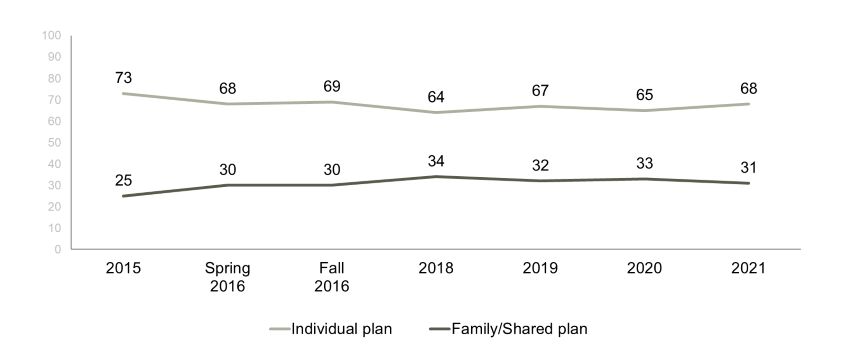
This line graph shows the proportion of people who have an individual plan or a family/shared plan over time. The 1371 respondents in the 2021 survey answered as follows:
Individual plan, 68%
Family/shared plan, 31%
The 1306 respondents in the 2020 survey answered as follows:
Individual plan, 65%
Family/shared plan, 33%
The 1322 respondents in the 2019 survey answered as follows:
Individual plan, 67%
Family/shared plan, 32%
The 1111 respondents in the 2018 survey answered as follows:
Individual plan, 64%
Family/shared plan, 34%
The 1277 respondents in the fall 2016 survey answered as follows:
Individual plan, 69%
Family/shared plan, 30%
The 925 respondents in the spring 2016 survey answered as follows:
Individual plan, 68%
Family/shared plan, 30%
The 1005 respondents in the 2015 survey answered as follows:
Individual plan, 73%
Family/shared plan, 25%
Individual/Family Shared Plan
QB1a. Is it an individual plan or a family or shared plan?
Base: Respondents who own a cell-phone, 2021 (n=1,371); 2020 (n=1,306), 2019 (n=1,322), 2018 (n=1,111), fall 2016 (n=1,277)
Promotion through Employer or Association
Only a small number of Canadians (7%) have a wireless plan that is part of a promotion through their employer or an association they belong to, which has remained relatively stable from year to year. Full details can be found in Exhibit 4.7.1.d below.
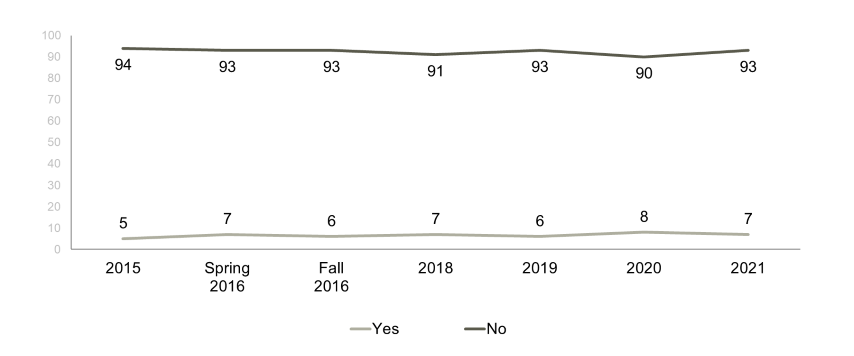
This line graph shows the proportion of people who have a plan that is part of a promotion through their employer over time. The 1371 respondents in the 2021 survey answered as follows:
Yes, 7%
No, 93%
The 1306 respondents in the 2020 survey answered as follows:
Yes, 8%
No, 90%
The 1322 respondents in the 2019 survey answered as follows:
Yes, 6%
No, 93%
The 1111 respondents in the 2018 survey answered as follows:
Yes, 7%
No, 91%
The 1277 respondents in the fall 2016 survey answered as follows:
Yes, 6%
No, 93%
The 925 respondents in the spring 2016 survey answered as follows:
Yes, 7%
No, 93%
The 1005 respondents in the 2015 survey answered as follows:
Yes, 5%
No, 94%
QB1d. Is your plan part of a promotion through your employer or an association you belong to, sometimes also called an employee purchase plan?
Base: Respondents who own a cell-phone, 2021 (n=1,371); 2020 (n=1,306), 2019 (n=1,322), 2018 (n=1,111), fall 2016 (n=1,277)
Minutes, Texts and Data
The majority of wireless plans continue to include text messaging (94%). The number of wireless plans with data (85%) has overtaken the number of plans with calling minutes (83%) for the first time.
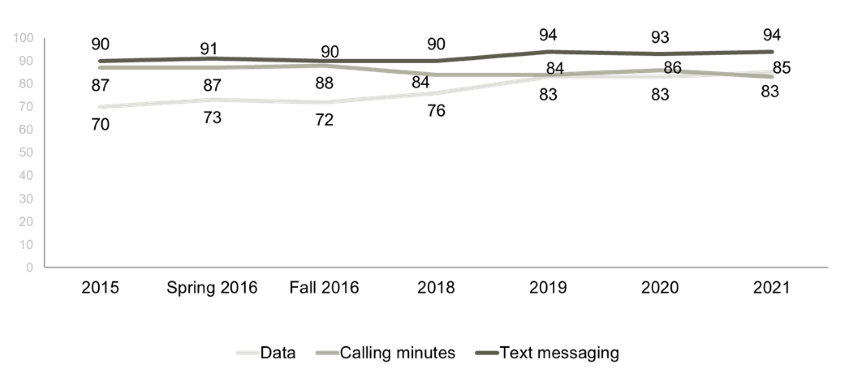
This line graph shows the proportion of people who have data, calling minutes and text messaging included in their wireless plan over time. The 1371 respondents in the 2021 survey answered as follows:
Data, 83%
Calling minutes, 85%
Text messaging, 94%
The 1306 respondents in the 2020 survey answered as follows:
Data, 83%
Calling minutes, 86%
Text messaging, 93%
The 1322 respondents in the 2019 survey answered as follows:
Data, 83%
Calling minutes, 84%
Text messaging, 94%
The 1111 respondents in the 2018 survey answered as follows:
Data, 76%
Calling minutes, 84%
Text messaging, 90%
The 1277 respondents in the fall 2016 survey answered as follows:
Data, 72%
Calling minutes, 88%
Text messaging, 90%
The 925 respondents in the spring 2016 survey answered as follows:
Data, 73%
Calling minutes, 87%
Text messaging, 91%
The 1005 respondents in the 2015 survey answered as follows:
Data, 70%
Calling minutes, 87%
Text messaging, 90%
QB2a. Which of the following are included in your wireless plan?
Base: Respondents who own a cell-phone, 2021 (n=1,371); 2020 (n=1,306), 2019 (n=1,322), 2018 (n=1,111), Fall 2016 (n=1,277), Spring 2016 (n=925), 2015 (n=1,005)
Phone included or Bring Your Own Device (BYOD)
BYOD rates have increased slightly over the past two years (39%; +5% vs. 2019).
As outlined in Table 4.7.3.b., older Canadians (75+) are most likely to bring their own device (56% vs. 35-41% among those under 75). Canadians who have individual and/or prepaid plans are also more likely to BYOD (43% vs 31%), as are those who have a pre-paid plan (71% vs. 36% among those with a monthly plan).
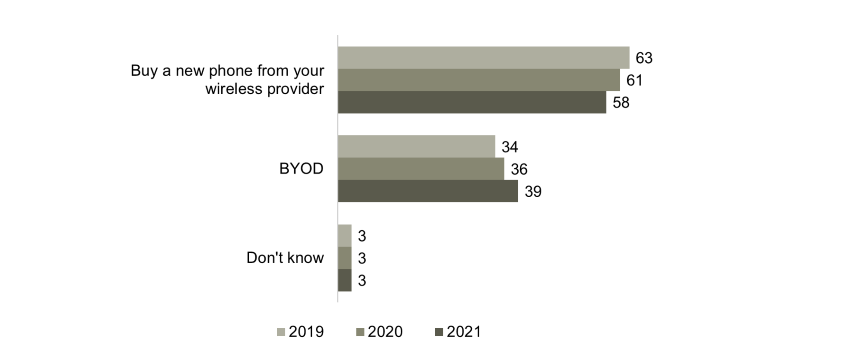
This bar graph shows the proportion of people who have opted for a contract where the device was bought new from the wireless provider, BYOD, the device was sold at discount, bought phone as part of the contract or don’t know if there was a phone included in the contract. The 1371 respondents who own a cell phone in the 2020 survey answered as follows:
Bought a new phone from wireless provider, 58%
BYOD, 39%
Don’t know, 3%
The 1306 respondents who own a cell phone in the 2020 survey answered as follows:
Bought a new phone from wireless provider, 61%
BYOD, 36%
Don’t know, 3%
The 1322 respondents who own a cell phone in the 2019 survey answered as follows:
Bought a new phone from wireless provider, 63%
BYOD, 34%
Don’t know, 3%
WC4. And does your plan include a phone that was sold to you at a reduced price as part of your contract or did you bring your own device also known as a BYOD plan?
Base: Total respondents who own a cell-phone, 2021 (n=1,371); 2020 (n=1,306), 2019 (n=1,322)
| Phone included with contract | Total (A) |
Age | Plan | Wireless Plans | |||||||
|---|---|---|---|---|---|---|---|---|---|---|---|
| 18-34 (D) |
35-54 (E) |
55+ (F) |
55-64 (G) |
65-74 (H) |
75+ (I) |
Family (J) |
Individual (K) |
Monthly (L) |
Pre-paid (M) |
||
| Base=actual | 1371 | 209 | 465 | 679 | 299 | 241 | 119 | 426 | 925 | 1234 | 119 |
| Buy a new phone from your wireless provider | 58 | 60I | 63FI | 52 | 56I | 56I | 39 | 65K | 55 | 62M | 26 |
| Bring your own device | 39 | 39 | 35 | 44E | 41 | 41 | 56DEGH | 31 | 43J | 36 | 71L |
| Don’t know | 3 | 1 | 2 | 4D | 4 | 3 | 5D | 3 | 2 | 2 | 3 |
WC4. When you signed up for your latest wireless plan, did you bring your own device, or did you buy a new phone from your wireless provider?
Note: Letters denote statistically significant difference. For example, if there is a B then the result is significantly higher than the corresponding result in column B.
Among those who purchased a new phone, few pay full price (9%). Compared to the previous year, more Canadians are starting a tab balance to purchase a new phone (51%; +10%). A tab balance involves the purchase of a phone at a reduced upfront cost, with the leftover cost added to an individual’s monthly bill to pay down this balance. Fewer (31%) are being given a discount on their phone versus 2020 (-6%).
As noted in Table 4.7.3.d, tab balances continue to be more prevalent among younger Canadians (18-54; 51-56%) than older Canadians (55+; 32-49%). Those 75+ are more likely to pay full price than those 18-74 (28% vs. 5-11%).
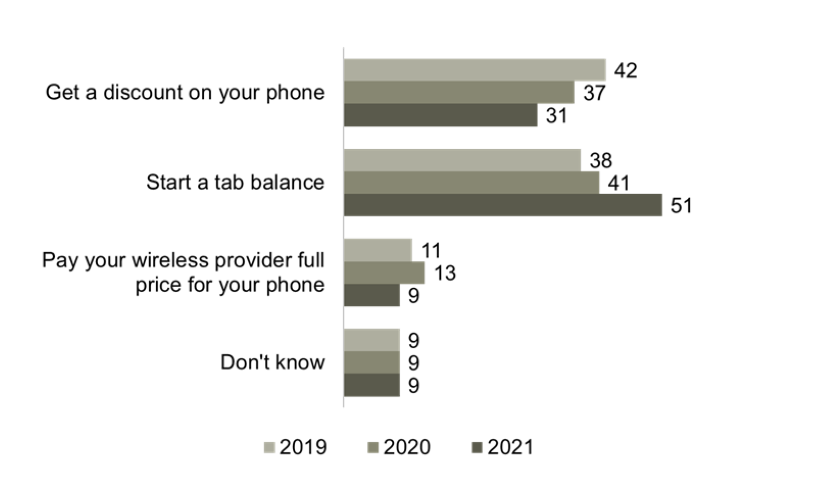
This horizontal bar graph shows the type of new phone purchased among those who purchased a new phone through their wireless provider. The 801 respondents who purchased a new phone through their wireless provider in the 2021 survey answered as follows:
Get a discount on their phone, 31%
Start a tab balance, 51%
Pay your wireless provider full price, 9%
Don’t know, 9%
The 801 respondents who purchased a new phone through their wireless provider in the 2020 survey answered as follows:
Get a discount on their phone, 37%
Start a tab balance, 41%
Pay your wireless provider full price, 13%
Don’t know, 9%
The 840 respondents who purchased a new phone through their wireless provider in the 2019 survey answered as follows:
Get a discount on their phone, 42%
Start a tab balance, 38%
Pay your wireless provider full price, 11%
Don’t know, 9%
WC4a. [IF QWC4 is Buy a new phone from your wireless provider] Did you:
Base: Total respondents who own a cell-phone, 2021 (n=801); 2020 (n=801), 2019 (n=840)
| Promotion through employer or association | Total (A) |
Age | |||||
|---|---|---|---|---|---|---|---|
| 18-34 (D) |
35-54 (E) |
55+ (F) |
55-64 (G) |
65-74 (H) |
75+ (I) |
||
| Base=actual | 801 | 128 | 295 | 366 | 171 | 138 | 49 |
| Get a discount on your phone | 31 | 32 | 33 | 29 | 32 | 30 | 19 |
| Start a tab balance | 51 | 56I | 51I | 46 | 49 | 47 | 32 |
| Pay your wireless provider full price for our phone | 9 | 5 | 10 | 11 | 9 | 6 | 28DEGH |
| Don’t know | 9 | 7 | 6 | 15E | 10 | 17DE | 21DE |
WC4a. [IF QWC4 is Buy a new phone from your wireless provider] Did you:
Note: Letters denote statistically significant difference. For example, if there is a B then the result is significantly higher than the corresponding result in column B.
In September 2017, the Television Service Provider (TVSP) Code came into effect establishing guidelines for television service providers. The TVSP Code ensures that television consumers are empowered to make informed decisions and that there is a more competitive television marketplace. Despite having been introduced more than three years ago, awareness remains low and has declined since the TVSP Code was initially introduced. In 2021, few (11%) clearly recall the TVSP Code while most do not recall it at all (60%). This is likely a function of the reduced media attention on the TVSP Code as time goes on.
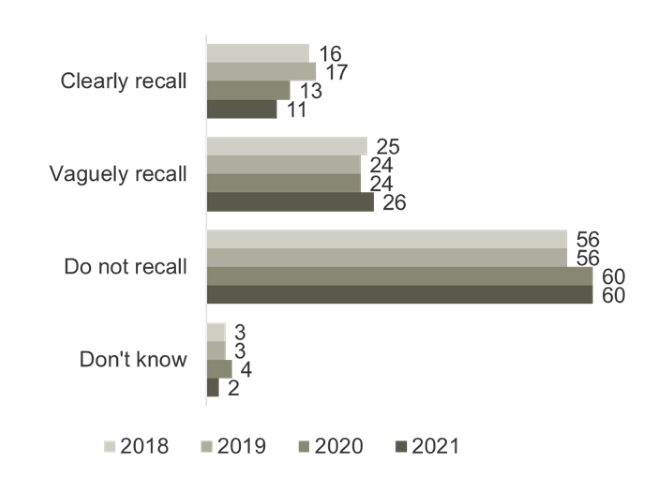
This horizontal graph shows the proportion of people who can clearly recall, vaguely recall, not recall or don’t know if they can recall hearing or seeing anything about the TV Service Provider Code. The 1102 respondents who subscribe to a TV service in the 2021 survey answered as follows:
Clearly recall, 11%
Vaguely recall, 26%
Do not recall, 60%
Don’t know, 2%
The 1060 respondents who subscribe to a TV service in the 2020 survey answered as follows:
Clearly recall, 13%
Vaguely recall, 24%
Do not recall, 60%
Don’t know, 4%
The 1060 respondents who subscribe to a TV service in the 2020 survey answered as follows:
Clearly recall, 13%
Vaguely recall, 24%
Do not recall, 60%
Don’t know, 4%
The 1107 respondents who subscribe to a TV service in the 2019 survey answered as follows:
Clearly recall, 17%
Vaguely recall, 24%
Do not recall, 56%
Don’t know, 3%
The 1096 respondents who subscribe to a TV service in the 2018 survey answered as follows:
Clearly recall, 16%
Vaguely recall, 25%
Do not recall, 56%
Don’t know, 3%
TVSP1. In September 2017, a Television Service Provider Code came into effect establishing guidelines for television service providers. The Code ensures that television consumers are empowered to make informed decisions and that there is a more competitive wireless marketplace. To what extent, if any would you say you recall hearing or seeing anything about this Code? Would you say you clearly recall, vaguely recall or do not recall?
Base: Total respondents who subscribe to a TV service, 2021 (n=1,102); 2020 (n=1,060), 2019 (n=1,107), 2018 (n=1,096),
As outlined in Table 4.8.1.b, demographics continue to play a role in recall of the TVSP Code, as Canadians aged 18-34 are still less likely to be aware of the TVSP Code (73% do not recall vs. 52-65% among those 35+), as are those with no tertiary education (70% vs. 56-59%). Those whose primary language is not an official language are also more likely to not recall the TVSP Code (79% vs. 58-59% among English or French speakers).
| Type of new phone purchase | Total (A) |
Age | Education | Language | |||||||||
|---|---|---|---|---|---|---|---|---|---|---|---|---|---|
| 18-34 (D) |
35-54 (E) |
55+ (F) |
55-64 (G) |
65-74 (H) |
75+ (I) |
HS or less (S) |
College (T) |
Univ. or more (U) |
Eng (B) |
Fr (C) |
Other (D) |
||
| Base=actual | 1102 | 97 | 342 | 646 | 264 | 231 | 135 | 245 | 306 | 522 | 746 | 248 | 108 |
| Do not recall | 60 | 73EFGH | 59 | 56 | 54 | 52 | 65H | 70TU | 56 | 59 | 59 | 58 | 79BC |
| Vaguely Recall | 26 | 20 | 27 | 29 | 30 | 32 | 25 | 22 | 28 | 28 | 27D | 31D | 12 |
| Clearly Recall | 11 | 7 | 11 | 13 | 14I | 14I | 6 | 6 | 14S | 12S | 13 | 8 | 8 |
| Don’t Know | 2 | * | 3 | 3 | 2 | 2 | 4 | 3 | 2 | 2 | 2 | 3 | 1 |
TVSP1. In September 2017, a Television Service Provider Code came into effect establishing guidelines for television service providers. The Code ensures that television consumers are empowered to make informed decisions and that there is a more competitive wireless marketplace. To what extent, if any would you say you recall hearing or seeing anything about this Code? Would you say you clearly recall, vaguely recall or do not recall?
Note: Letters denote statistically significant difference. For example, if there is a B then the result is significantly higher than the corresponding result in column B.
* Denotes less than 1%
Clarity of contracts has remained consistent over the last three years. Over half of Canadians are continuing to report they find their TV contracts clear and easy to understand (59%; rated 5, 6 or 7 on a scale from 1-7) and only a small portion (20%; rated 1, 2 or 3 on a scale from 1-7) are finding contracts difficult to understand.
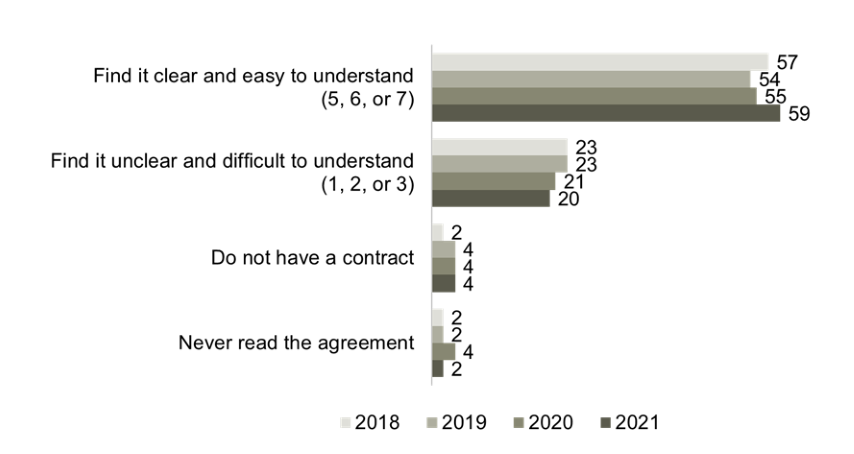
This horizontal bar graph shows the proportion of people who find their TV contracts clear and easy to understand, find it unclear and difficult to understand, don’t have a contract or who have never read their agreement. The 1102 respondents who subscribe to a TV service in the 2021 survey answered as follows:
Find it clear and easy to understand (5, 6 or 7), 59%
Find it unclear and difficult to understand (1, 2 or 3), 20%
Do not have a contract, 4%
Never read their agreement, 2%
The 1060 respondents who subscribe to a TV service in the 2020 survey answered as follows:
Find it clear and easy to understand (5, 6 or 7), 55%
Find it unclear and difficult to understand (1, 2 or 3), 21%
Do not have a contract, 4%
Never read their agreement, 4%
The 1107 respondents who subscribe to a TV service in the 2019 survey answered as follows:
Find it clear and easy to understand (5, 6 or 7), 54%
Find it unclear and difficult to understand (1, 2 or 3), 23%
Do not have a contract, 4%
Never read their agreement, 2%
The 1096 respondents who subscribe to a TV service in the 2018 survey answered as follows:
Find it clear and easy to understand (5, 6 or 7), 57%
Find it unclear and difficult to understand (1, 2 or 3), 23%
Do not have a contract, 2%
Never read their agreement, 2%
TVSP2. To what extent do you find your TV contract clear and easy to understand? Please use a 7-point scale where 1 means extremely unclear and difficult to understand and 7 means extremely clear and easy to understand.
Base: Total respondents who subscribe to a TV service, 2021 (n=1,102); 2020 (n=1,060); 2019 (n=1,107), 2018 (n=1,096)
The TVSP Code requires television service providers to ensure that customers are aware of the availability, price and content of their entry-level service offering (i.e., basic service package). Reports of being aware of the basic service package have remained steady since 2018, with just over half of TV service subscribers reporting they were informed (55%) while close to one-third (30%) do not believe they were informed of the basic service package. Service providers are required to inform new and old clients about the basic service, regardless of when their contracts were signed which suggests that consumer are still not being actively directed to the information on the basic service package.
Notably, as outlined in Table 4.8.3.b., those in the territories are less likely to say they were made aware of the basic service package (24% vs. 47-64% among other regions).
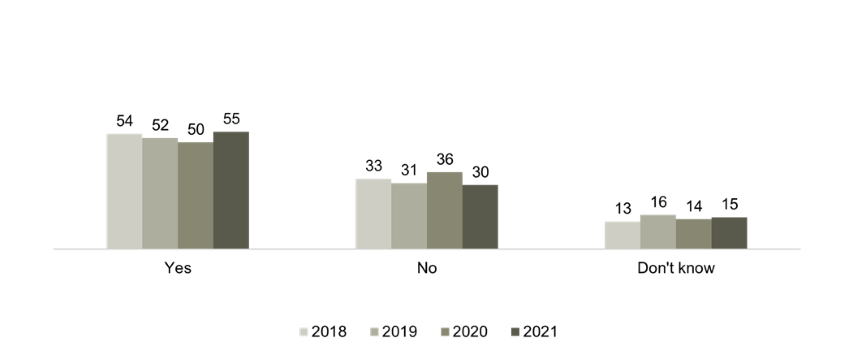
This bar graph shows the proportion of people who were informed of the basic service package offered by their TV service provider. The 1102 respondents who subscribe to a TV service in the 2021 survey answered as follows:
Yes, 55%
No, 30%
Don’t know, 15%
The 1060 respondents who subscribe to a TV service in the 2020 survey answered as follows:
Yes, 50%
No, 36%
Don’t know, 14%
The 1107 respondents who subscribe to a TV service in the 2019 survey answered as follows:
Yes, 52%
No, 31%
Don’t know, 16%
The 1096 respondents who subscribe to a TV service in the 2018 survey answered as follows:
Yes, 54%
No, 33%
Don’t know, 13%
TVSP4. The TVSP Code requires television service providers to ensure that customers are aware of the availability, price and content of their entry-level service offering, also known as the basic service package. Has your service provider informed you about their entry-level offering? This may have been by email, on the phone or via your monthly billing?
Base: Total respondents who subscribe to a TV service, 2021 (n=1,102); 2020 (n=1,060), 2019 (n=1,107), 2018 (n=1,096)
| Awareness of basic service package | Total (A) |
Region | |||||
|---|---|---|---|---|---|---|---|
| Atlantic (J) |
Quebec (K) |
Ontario (L) |
Prairies (M) |
B.C. (N) |
Territories (R) |
||
| Base=actual | 1102 | 99 | 258 | 290 | 296 | 122 | 37 |
| Yes | 55 | 47R | 62JMR | 55R | 51R | 60R | 24 |
| No | 30 | 45KLMN | 24 | 30 | 33K | 24 | 59KLMMN |
| Don't Know | 15 | 7 | 14 | 16 | 16 | 16 | 17 |
TVSP4. The TVSP Code requires television service providers to ensure that customers are aware of the availability, price and content of their entry-level service offering, also known as the basic service package. Has your service provider informed you about their entry-level offering? This may have been by email, on the phone or via your monthly billing?
Note: Letters denote statistically significant difference. For example, if there is a B then the result is significantly higher than the corresponding result in column B.
The TVSP Code requires television service providers to provide customers with a timeframe for when a service call to a residence will begin, explain potential charges associated with the service call, and explain how they may cancel or reschedule the service call. This requirement continues to work well, as few Canadians report problems related to service calls (13%).
As in 2020, some regional differences exist regarding service call related problems. Those living outside Atlantic Canada or Quebec were more likely to have experienced problems (14-22% vs. 5-8%). Those whose primary language is not an official language were also more likely to have experienced problems (27% vs. 6-14%).
Complete details can be found in Table 4.8.4.b below.

This bar graph shows the proportion of people who have experienced problems related to TV service calls. The 1060 respondents who subscribe to a TV service in the 2021 survey answered as follows:
Yes, 13%
No, 84%
Don’t know, 3%
The 1060 respondents who subscribe to a TV service in the 2020 survey answered as follows:
Yes, 14%
No, 82%
Don’t know, 4%
The 1107 respondents who subscribe to a TV service in the 2019 survey answered as follows:
Yes, 14%
No, 82%
Don’t know, 4%
The 1096 respondents who subscribe to a TV service in the 2018 survey answered as follows:
Yes, 14%
No, 84%
Don’t know, 2%
TVSP3. The TVSP Code requires television service providers to provide a customer with a timeframe for when a service call to a residence will begin, explain potential charges associated with the service call, and explain how you may cancel or reschedule the service call. Have you experienced problems related to service calls?
Base: Total respondents who subscribe to a TV service, 2021 (n=1,102); 2020 (n=1,060), 2019 (n=1,107), 2018 (n=1,096)
| Experienced issues related to service calls | Total (A) |
Region | Language | |||||||
|---|---|---|---|---|---|---|---|---|---|---|
| Atlantic (J) |
Quebec (K) |
Ontario (L) |
Prairies (M) |
B.C. (N) |
Terri-tories (R) |
Eng (B) |
Fr (C) |
Other (D) |
||
| Base=actual | 1102 | 99 | 258 | 290 | 296 | 122 | 37 | 746 | 248 | 108 |
| Yes | 14 | 5 | 8 | 16JK | 14J | 22JK | 9 | 14C | 6 | 27BC |
| No | 84 | 93LMN | 87N | 82 | 84N | 74 | 87 | 84D | 90D | 68 |
| Don't Know | 3 | 2 | 5 | 2 | 2 | 3 | 4 | 2 | 4 | 5 |
TVSP3. The TVSP Code requires television service providers to provide a customer with a timeframe for when a service call to a residence will begin, explain potential charges associated with the service call, and explain how you may cancel or reschedule the service call. Have you experienced problems related to service calls?
Note: Letters denote statistically significant difference. For example, if there is a B then the result is significantly higher than the corresponding result in column B.
Service providers can’t change the price of a TV channel or package of channels without informing their customers. When asked if their service provider had changed the price of their channels or packages without informing them, most Canadians continue to say they have not experienced an uninformed price change (76%). However, a small but significant minority (16%) continue to report uninformed price changes continue to occur.
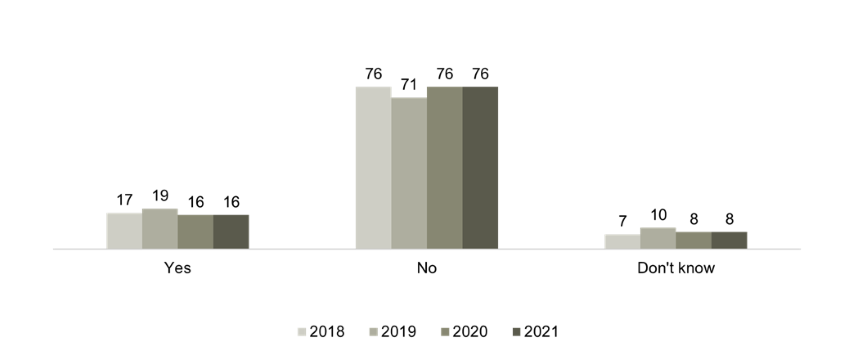
This bar graph shows the proportion of people that have experienced changes in the price of TV channels or packages without being informed in advance. The 1102 respondents who subscribe to a TV service in the 2021 survey answered as follows:
Yes, 16%
No, 76%
Don’t know, 8%
The 1060 respondents who subscribe to a TV service in the 2020 survey answered as follows:
Yes, 16%
No, 76%
Don’t know, 8%
The 1107 respondents who subscribe to a TV service in the 2019 survey answered as follows:
Yes, 19%
No, 71%
Don’t know, 10%
The 1096 respondents who subscribe to a TV service in the 2018 survey answered as follows:
Yes, 17%
No, 76%
Don’t know, 7%
TVSP5. In the past twelve months, has your TV service provider changed the price of a TV channel or package of channels without informing you in advance?
Base: Total respondents who subscribe to a TV service, 2021 (n=1,102); 2020 (n=1,060), 2019 (n=1,107), 2018 (n=1,096)
The number of Canadians who have made a complaint about their TV services in the past 12 months has remained steady over the past year (22%).
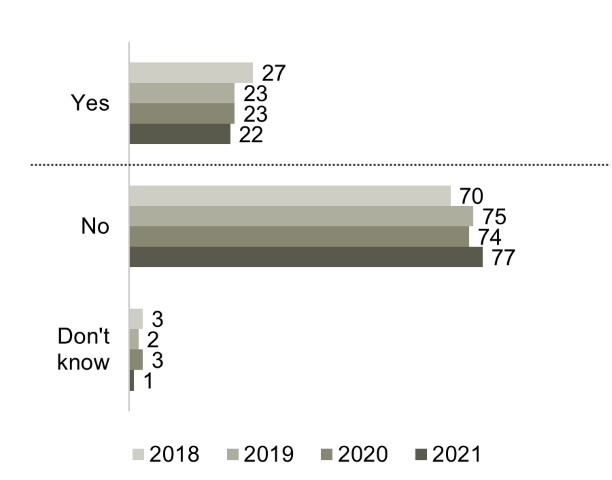
This horizontal bar graph shows the proportion of people who have made a complaint about their TV services in the last 12 months. The 1102 respondents who subscribe to a TV service in the 2021 survey answered as follows:
Yes, 22%
No, 77%
Don’t know, 1%
The 1060 respondents who subscribe to a TV service in the 2020 survey answered as follows:
Yes, 23%
No, 74%
Don’t know, 3%
The 1107 respondents who subscribe to a TV service in the 2019 survey answered as follows:
Yes, 23%
No, 75%
Don’t know, 2%
The 1096 respondents who subscribe to a TV service in the 2018 survey answered as follows:
Yes, 27%
No, 70%
Don’t know, 3%
TVSP6. Have you made a complaint about your TV services within the last 12 months?
Base: Total respondents who subscribe to a TV service, 2021 (n=1,102); 2020 (n=1,060), 2019 (n=1,107), 2018 (n=1,096)
The Internet Code is administered by the CCTS and applies to the largest national and regional Internet Services Providers (ISP), though the CRTC expects all ISPs to behave in a manner that is consistent with all the principles set out in the Internet Code. The Internet Code makes it easier for Canadians to understand their Internet service contracts, aims to prevent bill shock from overage fees and rate increases, and makes it easier for Canadians to switch ISPs. The Internet Code, among other things, ensures that customers will benefit from increased clarity in their interactions with ISPs; from clearer prices, including for bundled services, promotions, and time-limited discounts; and from increased clarity around service calls, service interruptions, security deposits, and disconnections.
Close to one-in-three (30%) recall hearing about the Internet Code. Of those who recall the Internet Code, most vaguely recall it (21%), while a few clearly recall it (7%).
As outlined in Table 4.9.1.b., those who live in the Territories are less likely to recall the Internet Code (53% vs. 66-76% in other regions). Those whose primary language is not an official language are also less likely to recall the Internet Code (82% do not recall vs. 64-69% among those whose first language is French or English).
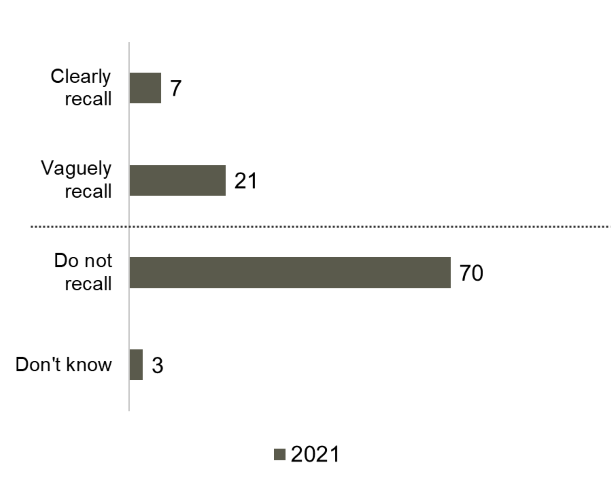
This horizontal bar graph shows the proportion of people who recall hearing or seeing anything about the Internet Code. The 1156 respondents in the 2021 survey answered as follows:
Clearly recall, 7%
Vaguely recall, 21%
Do not recall, 70%
Don’t know, 1%
QIC1. In 2019, the CRTC created an Internet Code to make it easier to understand Internet service contracts. The code also aims to better protect Canadians against bill shock and to offer subscribers greater flexibility in their choice of Internet service providers. To what extent, if any, would you say you recall hearing or seeing anything about the Internet Code? Would you say you clearly recall, vaguely recall or do not recall?
Base: Total respondents, 2021 (n=1,561)
| Recall of Internet Service Code | Total (A) |
Region | Language | |||||||
|---|---|---|---|---|---|---|---|---|---|---|
| Atlantic (J) |
Quebec (K) |
Ontario (L) |
Prairies (M) |
B.C. (N) |
Terri-tories (R) |
Eng (B) |
Fr (C) |
Other (D) |
||
| Base=actual | 1561 | 148 | 307 | 431 | 443 | 181 | 51 | 1074 | 294 | 193 |
| Clearly Recall | 7 | 6 | 5 | 7 | 8 | 8 | 7 | 8 | 5 | 4 |
| Vaguely Recall | 21 | 16 | 24 | 20 | 21 | 20 | 32J | 21D | 27D | 10 |
| Do not recall | 70 | 76KR | 66 | 72R | 69R | 70R | 53 | 69 | 64 | 82BC |
| Don't Know | 3 | 1 | 5M | 2 | 1 | 1 | 8LM | 2 | 4 | 4 |
QIC1. In 2019, the CRTC created an Internet Code to make it easier to understand Internet service contracts. The code also aims to better protect Canadians against bill shock and to offer subscribers greater flexibility in their choice of Internet service providers. To what extent, if any, would you say you recall hearing or seeing anything about the Internet Code? Would you say you clearly recall, vaguely recall or do not recall?
Among those who recall the Internet Code, most recall comes from television (33%), followed by ISPs (23%), or print media (21%). Full details can be found in Exhibit 3.9.2.a. below:
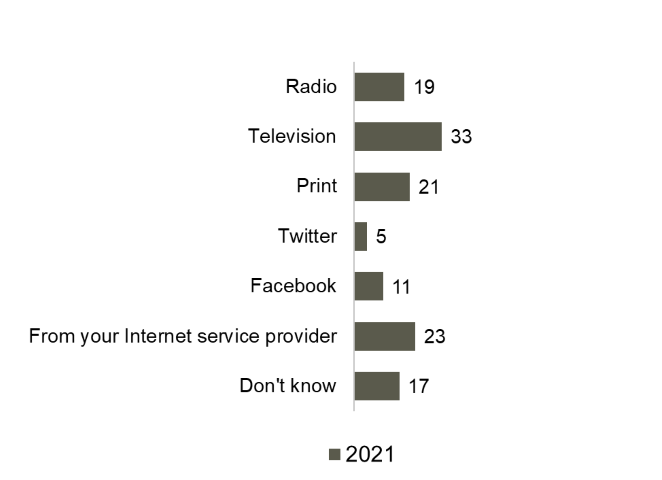
This horizontal bar graph shows where people recall hearing or seeing anything about the Internet Code. The 447 respondents who were aware of the Internet Code in the 2021 survey answered as follows:
Radio, 19%
Television, 33%
Print, 21%
Twitter, 5%
Facebook, 11%
From your Internet service provider, 23%
Don’t know, 17%
IC2. [If answered “Clearly Recall” or “Vaguely Recall” to IC1] Where do you recall hearing or seeing anything about the Internet Service Code? (READ LIST AND CHOOSE ALL THAT APPLY)?
Base: Total respondents, 2021 (n=447)
Canadians’ understanding of the mandate and role of the CRTC has remained stable over the past year. Thirty-five per cent (35%) consider themselves very well/well informed about the CRTC.
A number of demographic factors play a role in how informed one considers themselves to be about the CRTC:
Complete details can be found in Tables 4.10.1.b and 4.10.1.c below.
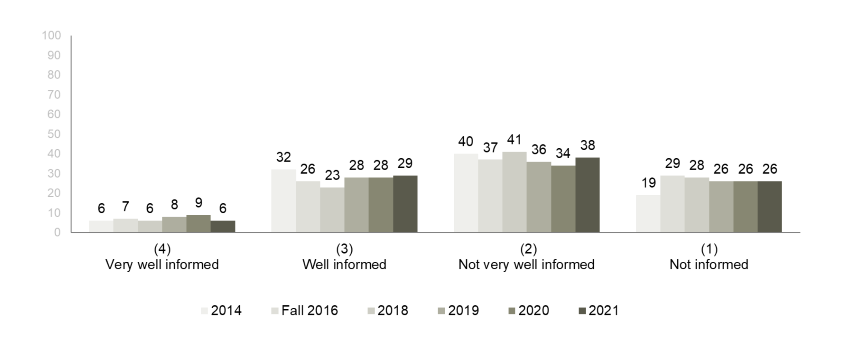
This bar graph shows the proportion of people who are very well informed, well informed, not very well informed and not informed of the mandate and role of the CRTC. The 1561 respondents in the 2021 survey answered as follows:
Very well informed, 6%
Well informed, 29%
Not very well informed, 38%
Not informed, 26%
The 1510 respondents in the 2020 survey answered as follows:
Very well informed, 9%
Well informed, 28%
Not very well informed, 34%
Not informed, 26%
The 1524 respondents in the 2019 survey answered as follows:
Very well informed, 8%
Well informed, 28%
Not very well informed, 36%
Not informed, 26%
The 1345 respondents in the 2018 survey answered as follows:
Very well informed, 6%
Well informed, 23%
Not very well informed, 41%
Not informed, 28%
The 1483 respondents in the Fall 2016 survey answered as follows:
Very well informed, 7%
Well informed, 26%
Not very well informed, 37%
Not informed, 29%
The 1284 respondents in the 2014 survey answered as follows:
Very well informed, 6%
Well informed, 32%
Not very well informed, 40%
Not informed, 19%
informed with the mandate and role of the CRTC
C1. Overall, how informed are you about the mandate and role of the CRTC?
Base: Total respondents, 2021 (n=1,561); 2020 (n=1,510), 2019 (n=1,524), 2018 (n=1,345), fall 2016 (n=1,483), 2014 (n=1,289)
| Level of informed with the mandate and role of the CRTC | Total (A) |
Gender | Age | Region | |||||||||||
|---|---|---|---|---|---|---|---|---|---|---|---|---|---|---|---|
| Male (B) |
Female (C) |
18-34 (D) |
35-54 (E) |
55+ (F) |
55-64 (G) |
65-74 (H) |
75+ (I) |
Atlantic (J) |
Quebec (K) |
Ontario (L) |
Prairies (M) |
B.C. (N) |
Terri-tories (R) |
||
| Base=actual | 1561 | 799 | 744 | 229 | 518 | 788 | 327 | 276 | 163 | 148 | 307 | 431 | 443 | 181 | 51 |
| Informed (4 and 3) | 35 | 39C | 30 | 23 | 41DI | 38D | 43DI | 39DI | 29 | 32 | 38 | 32 | 32 | 38 | 51JLM |
| Uninformed (2 and 1) | 63 | 60 | 66B | 76EFGH | 57 | 59 | 55 | 58 | 68EG | 68R | 60R | 67R | 65R | 60R | 31 |
QC1. Overall, how informed are you about the mandate and role of the CRTC?
Note: Letters denote statistically significant difference. For example, if there is a B then the result is significantly higher than the corresponding result in column B.
| Level of informed with the mandate and role of the CRTC | Total (A) |
Language | Education | ||||
|---|---|---|---|---|---|---|---|
| Eng (B) |
Fr (C) |
Other (D) |
HS or less (S) |
College (T) |
Univ. or more (U) |
||
| Base=actual | 1561 | 1074 | 294 | 193 | 362 | 416 | 738 |
| Informed (4 and 3) | 35 | 35D | 42D | 19 | 28 | 36S | 37S |
| Uninformed (2 and 1) | 63 | 62 | 57 | 78BC | 70TU | 61 | 61 |
QC1. Overall, how informed are you about the mandate and role of the CRTC?
Note: Letters denote statistically significant difference. For example, if there is a B then the result is significantly higher than the corresponding result in column B.
Canadians’ impressions of the CRTC have remained steady since 2019, and remain more positive than in Fall 2016 (35% vs. 29%; rated 4 or 5 on a 1-5 scale).

This line graph shows the proportion of people who have a favourable, neutral or unfavourable impression of the CRTC. The 1561 respondents in the 2021 survey answered as follows:
Net favourable, 35%
Neutral, 39%
Net unfavourable, 17%
The 1510 respondents in the 2020 survey answered as follows:
Net favourable, 33%
Neutral, 37%
Net unfavourable, 16%
The 1524 respondents in the 2019 survey answered as follows:
Net favourable, 34%
Neutral, 35%
Net unfavourable, 16%
The 1345 respondents in the 2018 survey answered as follows:
Net favourable, 31%
Neutral, 42%
Net unfavourable, 15%
The 1483 respondents in the fall 2016 survey answered as follows:
Net favourable, 29%
Neutral, 43%
Net unfavourable, 12%
The 1289 respondents in the 2014 survey answered as follows:
Net favourable, 34%
Neutral, 38%
Net unfavourable, 16
The respondents in the 2013 survey answered as follows:
Net favourable, 37%
Neutral, 42%
Net unfavourable, 16%
The respondents in the 2008 survey answered as follows:
Net favourable, 30%
Neutral, 47%
Net unfavourable, 13%
*Note: base sizes are unknown for the 2013 and 2008 survey.
QC2. What is your impression of the CRTC?
Base: Total respondents, 2021 (n=1,561); 2020 (n=1,510), 2019 (n=1,524), 2018 (n=1,345), Fall 2016 (n=1,483), 2014 (n=1,289)
Given that impressions of the CRTC have remained steady, it follows that most Canadians say their impression of the CRTC has not changed. Few report an improved (7%) or worsened (5%) opinion, with most remaining the same (79%).
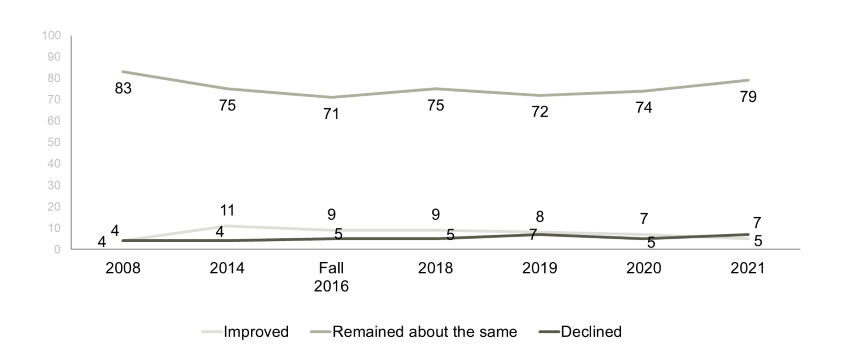
This line graph shows the proportion of people whose impression of the CRTC improved, remained about the same or declined over time. The 1561 respondents in the 2021 survey answered as follows:
Improved, 5%
Remained about the same, 79%
Declined, 7%
The 1510 respondents in the 2020 survey answered as follows:
Improved, 7%
Remained about the same, 74%
Declined, 5%
The 1524 respondents in the 2019 survey answered as follows:
Improved, 8%
Remained about the same, 72%
Declined, 7%
The 1345 respondents in the 2018 survey answered as follows:
Improved, 9%
Remained about the same, 75%
Declined, 5%
The 1483 respondents in the fall 2016 survey answered as follows:
Improved, 9%
Remained about the same, 71%
Declined, 5%
The 1289 respondents in the 2014 survey answered as follows:
Improved, 11%
Remained about the same, 75%
Declined, 4%
The respondents in the 2008 survey answered as follows:
Net favourable, 4%
Neutral, 83%
Net unfavourable, 4%
*Note: base sizes are unknown for the 2008 survey.
QC3. Over the past year, would you say your impression of the CRTC has:
Base: Total respondents, 2021 (n=1,561); 2020 (n=1,510), 2019 (n=1,524), 2018 (n=1,345), Fall 2016 (n=1,483), 2014 (n=1,289)
Survey Administration
A telephone survey was conducted among 1,561 Canadians age 18 years and older; 1,387 who have their own wireless plan and 174 with those who do not have their own wireless plan. Included in this sample were Canadians who reside in cell-phone only households (n=526). This sample also included Canadians that are under contract with TV service providers (n=1,042).
Interviews were conducted using a combination of random digit dialling (RDD) for the landline sample frame and pre-screened cell-phone only households (CPO) sample. Since this survey included pre-screened sample it is considered a non-probability sample and as such margin of error does not apply and conclusions from these results cannot be generalized to any population.
A pre-test consisting of 10 completed English interviews and 10 completed French interviews was undertaken on January 11, 2021. No changes were made after the pre-test and as such the data were included in the final data set. The survey was in field from January 20th – January 31, 2021.
To allow for regional analyses, regional quotas were also set as follows:
| Region | Wireless | Quota | Completions |
|---|---|---|---|
| Territories | With wireless | 50 | 50 |
| Without wireless | 0 | 0 | |
| British Columbia | With wireless | 150 | 150 |
| Without wireless | 30 | 31 | |
| Alberta | With wireless | 125 | 128 |
| Without wireless | 20 | 20 | |
| Manitoba | With wireless | 125 | 125 |
| Without wireless | 20 | 20 | |
| Saskatchewan | With wireless | 125 | 125 |
| Without wireless | 20 | 21 | |
| Ontario | With wireless | 350 | 350 |
| Without wireless | 50 | 50 | |
| Quebec | With wireless | 250 | 251 |
| Without wireless | 40 | 40 | |
| Atlantic | With wireless | 125 | 128 |
| Without wireless | 20 | 20 |
Survey data were weighted using the 2016 Census statistics with regard to region, age, gender and language. Further details about the methodology follow.
Questionnaire
This is a tracking survey and the overall objectives have not changed, although some questions were removed or added to the survey since the fall 2016 wave, and questions related to the Internet Code were added in 2021. CRTC provided Kantar with both English and French versions of the survey. The survey took approximately 15 minutes to complete.
Pre-test
A pre-test was undertaken on January 11, 2021, obtaining 10 English and 10 French completed interviews. The results were reviewed to ensure the survey was working as expected and that the questions were being interpreted as expected. Based on the results of the pre-test, minimal changes were required for the survey and as such the results of the 20 completes were included in the final data set.
Sample Design and Selection
A regionally stratified sample was drawn to achieve completions among Canadians who have a wireless plan that is not paid for by their employer and those who do not have any wireless plan. The sample was regionally stratified to ensure regional quotas were met.
A landline sample was provided by an internal random number generator that randomizes the last four digits of the phone number based on known area code/exchange combinations. Landline respondents were screened to ensure they qualified for the study. The person answering the phone was selected for the study if they were 18 years of age or older. Regional quotas were assigned by those with and without personal wireless plans.
Survey Administration
The telephone survey was conducted using computer assisted telephone interviewing (CATI) technology. CATI ensures the interview flows as it should with pre-programmed skip patterns. It also controls responses to ensure appropriate ranges and data validity. Sample is imported directly into the survey to ensure accurate recording of sample variables such as region. The system also controls automated scheduling and call-backs to ensure all appointments are adhered to.
Surveys were conducted in English or French as chosen by the respondent. Interviewing was conducted by fully trained interviewers and supervisors. A minimum of five per cent of all interviews were independently monitored and validated in real time.
All participants were informed of the general purpose of the research, they were informed of the sponsor and the supplier and that all of their responses would be confidential.
Margin of Errors
Since this survey included pre-screened sample it is considered a non-probabilistic sample and as such margin of error does not apply and conclusions from these results cannot be generalized to any population.
Weighting
Data were weighted by region, age, gender and language using 2016 Census Data.
| Region | Age | Gender | Population (N) | Population (%) |
|---|---|---|---|---|
| Atlantic | 18-34 | Male | 222,130 | 0.79 |
| Female | 223,220 | 0.79 | ||
| 35-54 | Male | 307,195 | 1.09 | |
| Female | 328,985 | 1.17 | ||
| 55+ | Male | 392,955 | 1.40 | |
| Female | 441,700 | 1.57 | ||
| Quebec | 18-34 | Male | 848,250 | 3.02 |
| Female | 842,360 | 3.00 | ||
| 35-54 | Male | 1,098,175 | 3.90 | |
| Female | 1,097,760 | 3.90 | ||
| 55+ | Male | 1,259,920 | 4.48 | |
| Female | 1,434,415 | 5.10 | ||
| Ontario | 18-34 | Male | 1,488,215 | 5.29 |
| Female | 1,483,160 | 5.27 | ||
| 35-54 | Male | 1,791,645 | 6.37 | |
| Female | 1,916,435 | 6.81 | ||
| 55+ | Male | 1,904,450 | 6.77 | |
| Female | 2,182,830 | 7.76 | ||
| Prairies | 18-34 | Male | 782,730 | 2.78 |
| Female | 762,790 | 2.71 | ||
| 35-54 | Male | 874,845 | 3.11 | |
| Female | 870,205 | 3.09 | ||
| 55+ | Male | 803,335 | 2.86 | |
| Female | 877,060 | 3.12 | ||
| BC & Territories | 18-34 | Male | 524,675 | 1.87 |
| Female | 517,040 | 1.84 | ||
| 35-54 | Male | 627,710 | 2.23 | |
| Female | 668,600 | 2.38 | ||
| 55+ | Male | 734,570 | 2.61 | |
| Female | 815,140 | 2.90 | ||
| Total | 28,122,500 | 100.00 |
| Language | Population (N) | Population (%) |
|---|---|---|
| English | 16,032,637 | 57.01 |
| French | 5,908,537 | 21.01 |
| Other | 6,181,326 | 21.98 |
| Total | 34,766,911 | 100.00 |
Response Rate
A total of 116,827 Canadian phone numbers were dialled, of which n=1524 completed the survey. The overall response rate achieved for the study was 2.79%. The following table outlines the sample disposition and response rate as per the MRIA guidelines.
| Total | Cell-phone Only (Prescreened) | Landline (Random Digit Dialling) | |
|---|---|---|---|
| Total Numbers Attempted | 126725 | 966 | 125759 |
| Invalid | 36404 | 7 | 36397 |
| Not in Service | 33122 | 7 | 33115 |
| Fax/modem | 2657 | 0 | 2657 |
| Business/non-residential | 625 | 0 | 625 |
| Unresolved (U) | 82850 | 145 | 82705 |
| Busy | 3866 | 3 | 3863 |
| No answer | 51952 | 119 | 51833 |
| Answering machine | 27032 | 23 | 27009 |
| Unresolved (IS) | 5653 | 204 | 5449 |
| Language problem/illness, incapable | 315 | 9 | 306 |
| Selected respondent not available | 267 | 25 | 242 |
| Refusal | 4727 | 119 | 4608 |
| Qualified respondent break-off | 344 | 51 | 293 |
| In-scope - Responding units (R) | 1818 | 610 | 1208 |
| Quota Full | 192 | 48 | 144 |
| Other disqualify - No Device not paid by employer (NWT/NU/YK only) | 1 | 1 | |
| Other disqualify - Occupation | 64 | 36 | 28 |
| Completed interviews | 1561 | 526 | 1035 |
| Response Rate = R/(U+IS+R) | 2.0% | 63.6% | 1.4% |
Non-response Bias
The response rate for this survey was 2.0%. In order to maximize response, the following procedures are undertaken:
Tabulated Data
Detailed tables are included under separate cover.
Background Information for the Interviewers
The Wireless Code came into effect in 2013 and was updated in 2017.
The TV Service Provider Code came into effect in 2017.
The Internet Code came into effect in January 31 2020.
Section A: Introduction and Screening
Hello/Bonjour. The Canadian Radio-television and Telecommunications Commission (CRTC), is conducting a survey among Canadian 18+ to understand their attitudes and opinions on communication issues. Would you prefer that I continue in English or French? Préférez-vous continuer en français ou en anglais? My name is from Kantar, the company commissioned to conduct this survey. The survey will take approximately 15 minutes. If you have any questions regarding the survey, I can provide you with contact details of someone at the CRTC.
Your participation in this survey is voluntary and confidential. Your responses will be kept anonymous and the information provided will be protected according to the requirements of the Privacy Act, Access to Information Act and any other pertinent legislation. Is now a good and safe time? May I continue?
| Yes | CONTINUE |
| No, other time | SCHEDULE CALLBACK |
| No/Refused | THANK AND TERMINATE |
[IF ASKED: Kantar is a professional research company hired by the Government of Canada to conduct this survey]
[ASK ALL] A1b. Do you have your own cell-phone, smartphone or other wireless device? In other words, a phone that is not paid for by your employer?
| YES | 1 |
| NO | 2 |
HV1. Hidden Variable: CPO Household
RECORD FROM SAMPLE
YES - CPO Household
NO
A1d. Does your household subscribe to a cable, satellite or IPTV TV service?
| Yes | 1 |
| No | 2 |
| Don’t Know/No Response (VOLUNTEERED) | 9 |
[IF ASKED: IPTV is a different way of getting traditional TV, similar to cable or satellite TV. IPTV is different from Netflix or other streaming services. (IPTV does not include Netflix)]
A2. Are you or is any member of your household or immediate family employed in any of the following businesses? [READ LIST]
| Market Research | 1 [THANK AND TERMINATE] |
| Public or media relations or advertising | 2 [THANK AND TERMINATE] |
| Any media company such as print, radio, TV | 3 [THANK AND TERMINATE] |
| Media monitoring | 4 [THANK AND TERMINATE] |
| Any telecommunications company | 5 [THANK AND TERMINATE] |
| No | 6 [CONTINUE] |
Section: Wireless Code
[ASK ALL]
I. RECALL OF WIRELESS CODE
WC1. In 2013 a Wireless Code was created to make wireless contracts clearer, limit early cancellation fees, and to contribute to a more competitive wireless marketplace. In 2017, the Code was updated to end unlocking fees. To what extent, if any would you say you recall hearing or seeing anything about this Code? Would you say you clearly recall, vaguely recall or do not recall?
| Clearly Recall | 1 |
| Vaguely Recall | 2 |
| Do not recall | 3 |
| Don’t Know | 99 |
PROGRAMMING INSTRUCTION:
IF NO AT A1B AND YES AT A1D SKIP TO SECTION TVSP Code
IF NO AT A1B AND NO AT A1D SKIP TO INTERNET SECTION IC1
II. TYPE OF WIRELESS CONTRACT
The next few questions are about your cell or wireless phone service contract or plan.
[Interviewer note: If say “I don’t have a plan/I have pay-as-you-go/month-to-month,” say: “this question is about your service agreement or plan, regardless of whether you have signed a contract for a specific time period, are month-to-month or use pre-paid cards.”]
INDIVIDUAL, FAMILY AND SHARED PLANS
B1a. Is it an individual plan or a family or shared plan?
[Interviewer note: If unsure about the difference, say “Do you pay only for one person (which is an individual plan) or do you share a plan with your family and pay together (which is a family plan)?”]
| Individual plan | 1 |
| Family/shared plan | 2 |
| [DO NOT READ] Other [SPECIFY] | 77 |
| Don’t Know (DO NOT READ) | 99 |
WC2. [ASK If answered “family/shared plan” to B1a]
How many members are on your shared plan?
| 2 | 1 |
| 3 | 2 |
| 4 | 3 |
| 5+ | 4 |
| Don’t Know (DO NOT READ) | 99 |
MONTHLY, PREPAID, AND PAY-AS-YOU-GO PLANS
B1c. And, is it a monthly plan, or a prepaid or pay-as-you-go plan?
[Interviewer note: If unsure about the difference, say “If you pay your bill after you use your wireless service, it’s a monthly or post-paid plan. If you pay before you use your wireless service, it’s a prepaid or pay-as-you-go plan.“]
| Monthly/post-paid (paying after) | 1 |
| Prepaid/pay-as-you-go (paying before) | 2 |
| [DO NOT READ] Other [SPECIFY] | 77 |
| Don’t Know (DO NOT READ) | 99 |
CORPORATE CONTRACTS (EMPLOYEE PURCHASE PLANS)
B1d. Is your plan part of a promotion through your employer or an association you belong to, sometimes also called an employee purchase plan?
| Yes | 1 |
| No | 2 |
| Don’t Know (D NOT READ) | 99 |
III. SERVICES INCLUDED IN THE WIRELESS SERVICE PLAN
(TEXT, VOICE, DATA)
DISPLAY: Now I would like to ask you a few questions about the services that are included in your wireless plan.
B2a. Which of the following are included in your wireless plan?
PROGRAMMING NOTE: PLEASE ALLOW YES NO AND DON’T KNOW AS OPTIONS
IV. DEVICES
PHONE INCLUDED WITH CONTRACT (BYOD, TAB CONTRACTS, AND OTHER DEVICE SUBSIDIES)
WC4. When you signed up for your latest wireless plan, did you bring your own device, or did you buy a new phone from your wireless provider?
[Interviewer note: If the respondent is unsure about the meaning of bring your own device, say “bring your own device is where you already own your mobile device and are simply purchasing the cellular service from a wireless company.”
| Bring your own device | 1 |
| Buy a new phone from your wireless service provider | 2 |
| Don’t Know (DO NOT READ) | 99 |
PROGRAMMING INSTRUCTION: ONLY ASKWC4A IF QWC4 is Buy a new phone from your wireless service provider
QWC4A: Did you:
| Pay your wireless service provider full price for your phone | 1 |
| Get a reduction on the price of your phone | 2 |
| Choose a tab balance contract | 3 |
| Don’t Know (DO NOT READ) | 99 |
INTREVIEWER INSTRUCTION: If the respondent is unsure about the meaning of a tab balance, say “Tab balances are when you buy a phone at a reduced upfront cost and the leftover cost of the phone goes onto your account, creating a tab balance. Each month, a percentage of your bill is used to pay down your account balance”]
V. DATA SERVICES
[ASK If answered “Data” to B2a]
Now, I would like to ask you a few questions about the data services that are included in your wireless plan.
DATA PLANS
B4. Some wireless plans have unlimited data and some have limited data. When a plan includes a monthly data limit, you may have to pay data overage fees if you use more data in a month than is included in your plan.
How much data is currently included in your plan each month?
[Interviewer note: If the respondent is unsure about the meaning of data, say “This is what you need to browse the Internet, access applications or your emails with your wireless device when it is not connected to WiFi.”]
[DO NOT READ LIST]
PROGRAMMING INSTRUCTION: PLEASE PROGRAM TO ALLOW NUMBERICAL ENTRY AS FOLLOWS
Mega Bytes (MB) – DO NOT ALLOW ENTRY UNDER 100
Giga Bytes (GB) – DO NOT ALLOW ENTRY OVER 100
Unlimited
None – no data in plan
Don’t Know
[Interviewer note: If respondent indicates a number under 100 MegaBytes please ask them if they mean MegaBytes or GigaBytes. If there is confusion, please code as Don’t Know”]
HOW TO MANAGE DATA USE
PROGRAMMING NOTE: PLEASE ALLOW YES NO AND DONT KNOW AS OPTIONS
B5a. [ASK If do not answer “Unlimited or None” to B4] Which of the following activities, if any, do you use to manage or limit your data use? Select all that apply.
| Use tools to track your data use | 1 |
| Reduce your data use after you get a notification that you are nearing your limit | 2 |
| Use WIFI when available instead of data | 3 |
| Other (specify) | 4 |
| I do not limit my data use (DO NOT READ)* | 5 |
| Don’t Know (DO NOT READ) | 99 |
EASE OF MANAGING DATA
WC6. [ASK If answered “Data” to B2a and not code 3 (NO DATA) at B4]
How easy do you find it to manage the data used by yourself and/or your family each month?
[Interviewer note: If unsure about the meaning of data, say “This is what you need to browse the Internet, access applications or your emails with your wireless device.”]
| 7 – Extremely easy | 07 |
| 6 | 06 |
| 5 | 05 |
| 4 | 04 |
| 3 | 03 |
| 2 | 02 |
| 1 – Extremely difficult | 01 |
| I DON’T USE MY DATA (DO NOT READ) | 09 |
| Don’t Know (DO NOT READ) | 99 |
DATA OVERAGE FEES
B8. [“Data” to B2a and not code 3 (NO DATA) at B4.] In the past 12 months, how often have you paid data overage fees?
READ LIST
[Interviewer note: If the respondent is unsure about the meaning of data, say “This is what you need to browse the Internet, access applications or your emails with your wireless device.”]
| Never | 1 |
| 1-2 times | 2 |
| 3-6 times | 3 |
| 7-9 times | 4 |
| 10-12 times | 5 |
| Don’t Know- DO NOT READ | 99 |
VI. BILL SHOCK
B10. During the last year, have you experienced ‘bill shock, meaning a surprisingly high bill?
READ LIST
| Yes | 1 |
| No | 2 |
| Don’t Know DO NOT READ | 99 |
REASON FOR BILL SHOCK
B10a. [If answered “Yes” to B10] What was the main reason for the ‘bill shock you experienced?
DO NOT READ LIST – SELECT ALL THAT APPLY
INTERVIEWER NOTE: IF RESPONDENT SAYS ‘ROAMING/ROAMING FEES, CLARIFY WHETHER THIS WAS WITHIN CANADA OR IN ANOTHER COUNTRY
| Family/shared plans – difficulties managing use | 01 |
| International travel – roaming fees | 02 |
| Domestic travel – roaming fees | 03 |
| Data overage fees | 04 |
| Call minute overage fees | 05 |
| Long distance fees | 06 |
| Text overage fees | 07 |
| Billing issues/errors/mistakes | 08 |
| Unexpected set-up fee or service charge | 09 |
| Unexpected fees (Network access fee/9-1-1, etc.) | 10 |
| I was not given the plan/deal I was promised | 11 |
| Other (Specify) | 77 |
| Don’t Know (DO NOT READ) | 99 |
AMOUNT OF BILL SHOCK
B10b. [If answered “Yes” to B10] What was the amount of the unexpected charges on your bill?
READ LIST
| Less than $50 more than your usual monthly bill | 01 |
| $50 - $100 | 02 |
| $101 - $250 | 03 |
| $251 - $500 | 04 |
| $501 - $1000 | 05 |
| Greater than $1000 | 06 |
| Don’t Know DO NOT READ | 99 |
ROAMING FEES WHILE TRAVELING
B9. If you use your plan while traveling, you may be charged roaming fees. How easy do you find it to manage your roaming charges when you are traveling?
Please use a 7-point scale where 1 means extremely difficult and 7 means extremely easy.
| 7 – Extremely easy | 07 |
| 6 | 06 |
| 5 | 05 |
| 4 | 04 |
| 3 | 03 |
| 2 | 02 |
| 1 – Extremely difficult | 01 |
| I don’t travel with my phone (DO NOT READ) | 08 |
| Don’t Know (DO NOT READ) | 99 |
VII. COMPLAINTS
B11a. Have you made a complaint about your wireless services in the past 12 months?
| Yes | 1 |
| No | 2 |
| Don’t Know (DO NOT READ) | 99 |
SUBJECT OF COMPLAINTS
B11b. [ASK If answered “Yes” to B11a] What was your complaint about? READ LIST IF NEEDED CHOOSE ALL THAT APPLY
| Misleading information about the terms of your contract | 1 |
| Misleading or aggressive sales practices | 13 |
| Incorrect charge on your bill | 2 |
| Legitimacy or amount of early cancellation fee | 3 |
| Inadequate quality of service | 4 |
| Credit or refund not received | 5 |
| Data charges | 6 |
| Breach of contract | 7 |
| Change to contract without notice | 8 |
| 30-day cancellation policy | 9 |
| Unlocking phone | 10 |
| Credit reporting | 11 |
| Unlimited data | 12 |
| Other [specify] | 77 |
| Don’t Know(Do not read) | 99 |
NOTES TO INTERVIEWER: PLEASE FAMILIARIZE YOURSELF WITH THE FOLLOWING BEFORE INTERVIEW READ IF REQUIRED
WHO DID YOU COMPLAIN TO?
WC7. [ASK If answered “Yes” to B11a] Who did you complain to? Was it your service provider, the Commission for Complaints for Telecom-television Services, also knowns as the CCTS, or both?
| Service provider | 1 |
| CCTS | 2 |
| Both | 3 |
| Don’t Know (DO NOT READ) | 99 |
VIII. CLARITY AND EXPLANATIONS
Now, I would like to ask you a few questions about how clear and easy you find your wireless contract to understand.
EXPLANATION OF TRIAL PERIOD
WC8. The Code requires service providers to include a trial period for new contracts that include a device. During the trial period, you can cancel your contract without penalty. This trial period now has to be half of a month of service and include half the service included in your monthly plan.
How clearly did your service provider explain the trial period to you?
Please use a 7-point scale where 1 means extremely unclear and 7 means extremely clear.
| 7 – Extremely clear | 07 |
| 6 | 06 |
| 5 | 05 |
| 4 | 04 |
| 3 | 03 |
| 2 | 02 |
| 1 – Extremely unclear | 01 |
| DO NOT READ: Do not have a contract | 08 |
| DO NOT READ: Never read the agreement | 09 |
| DO NOT READ: Did not have a trial period | 10 |
| DO NOT READ: Don’t Know | 99 |
EXPLANATION OF CANCELLATION FEES
WC9. When you signed your contract or accepted your service agreement, how clearly did your service provider explain any fees that would apply if you cancel your contract or agreement early? Please use a 7-point scale where 1 means extremely unclear and 7 means extremely clear.
| 7 – Extremely clear | 07 |
| 6 | 06 |
| 5 | 05 |
| 4 | 04 |
| 3 | 03 |
| 2 | 02 |
| 1 – Extremely unclear | 01 |
| DO NOT READ: Do not have a contract | 08 |
| DO NOT READ: Never read the agreement | 09 |
| DO NOT READ: Don’t Know | 99 |
WC10. Do you find your contract clear and easy to understand? Please use a 7-point scale where 1 means extremely unclear and difficult to understand and 7 means extremely clear and easy to understand.
| 7 – Extremely clear and easy to understand | 07 |
| 6 | 06 |
| 5 | 05 |
| 4 | 04 |
| 3 | 03 |
| 2 | 02 |
| 1 – Extremely unclear and difficult to understand | 01 |
| DO NOT READ: Do not have a contract | 08 |
| DO NOT READ: Never read the agreement | 09 |
| DO NOT READ: Don’t Know | 99 |
IX. CHANGES
CHANGES TO YOUR CONTRACT
WC11. Have you ever become aware that your service provider changed your plan without expressly making you aware of how the terms and conditions had changed?
| Yes | 1 |
| No | 2 |
| Don’t Know | 99 |
[ASK ALL]
CHANGING SERVICE PROVIDERS
WC16. Have you changed wireless service providers in the last two years?
| Yes | 1 |
| No | 2 |
| Don’t Know | 99 |
REASONS FOR CHANGING SERVICE PROVIDER
WC12. [If answered “Yes” to WC16] Why did you change service provider? (DO NOT READ LIST - SELECT ALL THAT APPLY)
| Your contract had ended | 1 |
| You were no longer satisfied with your service provider | 2 |
| Offered a better deal with a different provider | 3 |
| Needed a new phone / to upgrade phone | 4 |
| Other [open ended] | 77 |
| Don’t Know | 99 |
EASE OF SWITCHING
WC13 [If answered “Yes” to WC16] How easy or difficult was it to switch service providers? Please use a 7-point scale where 1 means extremely difficult and 7 means extremely easy.
| 7 – Extremely easy | 07 |
| 6 | 06 |
| 5 | 05 |
| 4 | 04 |
| 3 | 03 |
| 2 | 02 |
| 1 – Extremely difficult | 01 |
| DO NOT READ: Don’t Know | 99 |
REASONS SWITCHING WAS DIFFICULT
WC14. [If answered 1,2 OR 3 at WC13] Was there a reason why switching providers was difficult for you? (DO NOT READ LIST – SELECT ALL THAT APPLY)
| Technical issues | 01 |
| Difficulty retaining phone number | 02 |
| High costs of ending contract | 03 |
| Could not get the phone you wanted | 04 |
| Other [open ended] | 77 |
| Don’t Know | 99 |
Section: TVSP Code
ASK TVSP CODE section if yes at A1d
The next few questions are about your TV service provider. By this we mean your cable, satellite or IPTV provider. Please do not include streaming services such as Netflix
INTERVIEWER INSTRUCTION: IF RESPONDENT INDICATES THEY DO NOT HAVE CABLE, SATELITE OR IPTV SERVICES SKIP THIS SECTION
TVSP1. In September 2017, a Television Service Provider Code came into effect establishing guidelines for television service providers. The Code ensures that consumers of television services are empowered to make informed decisions and that there is a more competitive wireless marketplace. To what extent, if any would you say you recall hearing or seeing anything about this Code? Would you say you clearly recall, vaguely recall or do not recall?
| Clearly Recall | 1 |
| Vaguely Recall | 2 |
| Do not recall | 3 |
| Don’t Know(DO NOT READ) | 99 |
TVSP2. To what extent do you find your TV contract clear and easy to understand? Please use a 7-point scale where 1 means extremely unclear and difficult to understand and 7 means extremely clear and easy to understand.
| 7 – Extremely clear and easy to understand | 07 |
| 6 | 06 |
| 5 | 05 |
| 4 | 04 |
| 3 | 03 |
| 2 | 02 |
| 1 – Extremely unclear and difficult to understand | 01 |
| DO NOT READ: Do not have a contract | 08 |
| DO NOT READ: Never read the agreement | 09 |
| DO NOT READ: Don’t Know | 99 |
TVSP3. The TVSP Code requires television service providers to provide a customer with a timeframe for when a service call to a residence will begin, explain potential charges associated with the service call, and explain how you may cancel or reschedule the service call. Have you experienced problems related to service calls?
| Yes | 1 |
| No | 2 |
| Don’t Know | 99 |
TVSP4. The TVSP Code requires television service providers to ensure that customers are aware of the availability, price and content of their entry-level service offering, also known as the basic service package. Has your service provider informed you about their entry-level offering? This may have been by email, on the phone or via your monthly billing?
| Yes | 1 |
| No | 2 |
| Don’t Know | 99 |
TVSP5. In the past twelve months, has your TV service provider changed the price of a TV channel or package of channels without informing you in advance?
| Yes | 1 |
| No | 2 |
| Don’t Know | 99 |
TVSP6. Have you made a complaint about your TV services within the last 12 months?
| Yes | 1 |
| No | 2 |
| Don’t Know | 99 |
SUBJECT OF COMPLAINTS
TVSP6b. [ASK If answered “Yes” to TVSP6] What was your complaint about? READ LIST IF NEEDED CHOOSE ALL THAT APPLY
| Misleading information about the terms of your contract | 1 |
| Misleading or aggressive sales practices | 2 |
| Incorrect charge on your bill | 3 |
| Legitimacy or amount of early cancellation fee | 4 |
| Inadequate quality of service | 5 |
| Credit or refund not received | 6 |
| Breach of contract | 7 |
| Change to contract without notice | 8 |
| 30-day cancellation policy | 9 |
| Credit reporting | 10 |
| Installation | 11 |
| Service calls | 12 |
| Other [specify] | 77 |
| Don’t Know(Do not read) | 99 |
NOTES TO INTERVIEWER: PLEASE FAMILIARIZE YOURSELF WITH THE FOLLOWING BEFORE INTERVIEW READ IF REQUIRED
Section: Internet Code ASK ALL
IC1. In 2019, the CRTC created an Internet Service Code to make it easier to understand internet service contracts. The code also aims to better protect Canadians against bill shock and to offer subscribers greater flexibility in their choice of Internet service providers. To what extent, if any, would you say you recall hearing or seeing anything about the Internet Code? Would you say you clearly recall, vaguely recall or do not recall?
| Clearly Recall | 1 |
| Vaguely Recall | 2 |
| Do not recall | 3 |
| Don’t Know | 99 |
IC2. [If answered “Clearly Recall” or “Vaguely Recall” to IC1] Where do you recall hearing or seeing anything about the Internet Service Code? (READ LIST AND CHOOSE ALL THAT APPLY)
| Radio | 1 |
| Television | 2 |
| 3 | |
| 4 | |
| 5 | |
| From your Internet service provider | 6 |
| Don’t Know | 99 |
Section CRTC: CRTC ASK ALL
The Canadian Radio-television and Telecommunications Commission or CRTC is an independent agency of government, responsible for regulating Canada's broadcasting and telecommunications systems.
C1. Overall, how informed are you about the mandate and role of the CRTC? (READ LIST)
| Very well informed | 1 |
| Well informed | 2 |
| Not very well informed | 3 |
| Not informed | 4 |
| Don’t Know (do not read) | 99 |
C2. What is your impression of the CRTC? Would you say it is: (READ LIST)
[Repeat CRTC definition, if necessary: The Canadian Radio-television and Telecommunications Commission or CRTC is an independent agency of government, responsible for regulating Canada's broadcasting and telecommunications systems.
| Very favourable | 1 |
| Somewhat favourable | 2 |
| Neutral | 3 |
| Somewhat unfavourable | 4 |
| Very unfavourable | 5 |
| Don’t Know (Do not read) | 99 |
C3. Over the past year, would you say your impression of the CRTC has: (READ LIST)
[Repeat CRTC definition, if necessary]
The Canadian Radio-television and Telecommunications Commission or CRTC is an independent agency of government, responsible for regulating Canada's broadcasting and telecommunications systems].
| Improved | 1 |
| Declined | 2 |
| Remained about the same | 3 |
| Don’t Know (Do not read) | 99 |
Section: Demographics
Thank you, now we have a few questions for classifications purposes. Please be assured that your responses will remain confidential.
D1. What is your gender?
| Male | 1 |
| Female | 2 |
| Other | 3 |
| [DO NOT READ] Prefer not to answer | 9 |
D2. What is your year of birth?
[RECORD YEAR TO CALCULATE AGE] Don’t Know/refused D3 [IF D2 = Don’t Know/refused] For classification purposes, could you tell me whether your age is: [READ LIST]
| Between 18 and 24 | 1 |
| Between 25 and 34 | 2 |
| Between 35 and 44 | 3 |
| Between 45 and 54 | 4 |
| Between 55 and 64 | 5 |
| Between 65 or older | 6 |
| [DO NOT READ] Prefer not to answer) | 9 |
[ASK ALL]
D4. What are the first 3 characters of your postal code?
| The 1st 3 characters of your postal code | |
| [DO NOT READ] Prefer not to answer |
D5. What level of education have you completed? [READ IF NECESSARY - CODE ONE ONLY]
| Less than a high school diploma or equivalent | 1 |
| High School diploma or equivalent | 2 |
| Registered Apprenticeship or other trades certificate or diploma | 4 |
| College, CEGEP or other non-university certificate or diploma | 5 |
| University certificate or diploma below bachelors level | 6 |
| Bachelor’s degree | 7 |
| Post graduate degree above bachelors level | 8 |
| [DO NOT READ] Prefer not to answer | 99 |
D6. What is your mother tongue, (that is, the language you first learned at home)?
(DO NOT READ)
[CODE ONE ONLY]
| French | 2 |
| English | 1 |
| Other (SPECIFY) | 8 |
| Don’t Know/No Response (VOLUNTEERED) | 99 |
D7. Which category is your total household income? That is, the total income of all persons in your household, before taxes? [READ - CODE ONE ONLY]
| Under $20,000 | 1 |
| $20,000 to under $40,000 | 2 |
| $40,000 to under $60,000 | 3 |
| $60,000 to under $80,000 | 5 |
| $80,000 to under $100,000 | 6 |
| $100,000 to under $150,000 | 7 |
| $150,000 and above | 8 |
| [DO NOT READ] Refused | 99 |
D8. Does your household subscribe to a residential telephone service, also referred to as a landline?
| Yes | 1 |
| No | 2 |
| Don’t Know | 3 |
| [DO NOT READ] Prefer not to answer | 99 |
D9. How many cellular phones are there in your household?
| 0 | 0 |
| 1 | 1 |
| 2 | 2 |
| 3 | 3 |
| 4 or more | 4 |
| Don’t Know | 5 |
| [DO NOT READ] Prefer not to answer | 99 |
D10. Which of the following categories best describes your current employment status? Are you…? [READ - CODE ONE ONLY]
| Working full-time (35 or more hours per week) | 1 |
| Working part-time (less than 35 hours per week) | 2 |
| Self-employed | 3 |
| Unemployed, but looking for work | 4 |
| Full-time student | 5 |
| Retired | 6 |
| Not in the workforce (Full-time homemaker or unemployed but not looking for work | 7 |
| Other employment status | 8 |
| [DO NOT READ] Refused | 99 |
Those are all the questions I have for you today.
Thank you for your time on this important study! Once compiled, the results, will be made available on the Library and Archives Canada website. [IF ASKED: at https://www.bac-lac.gc.ca/].